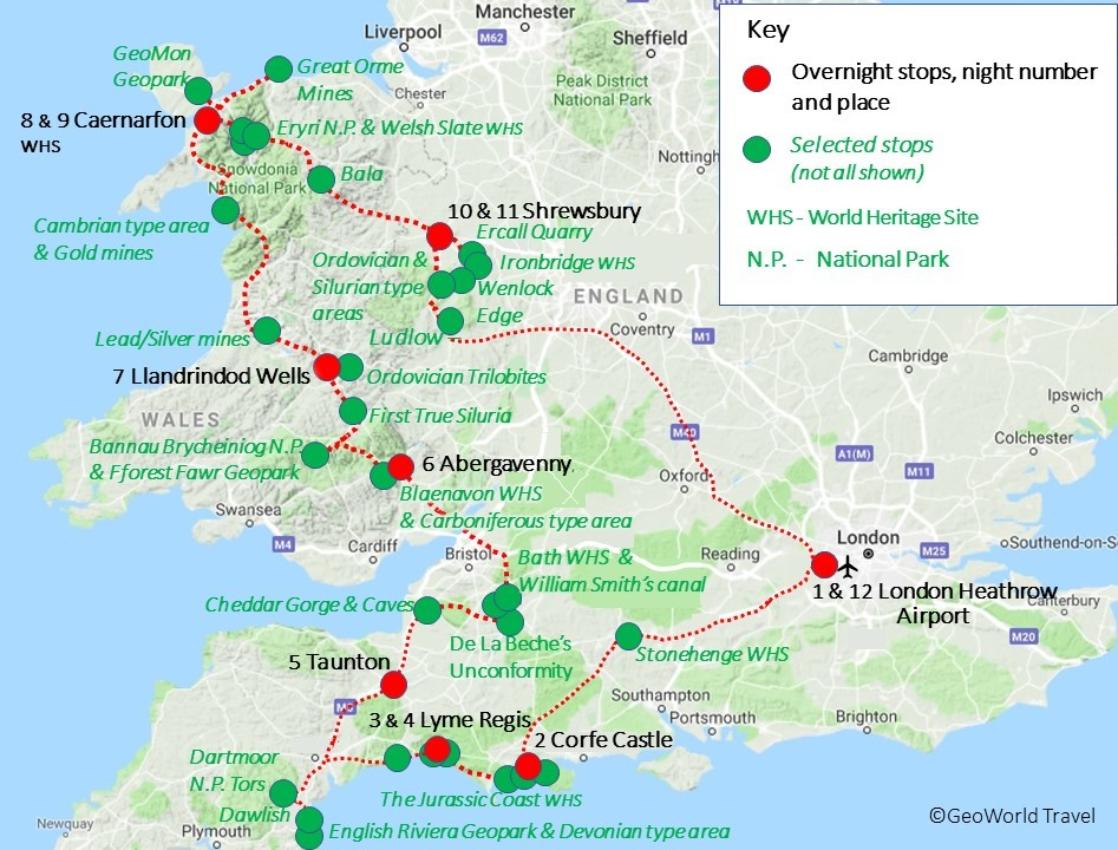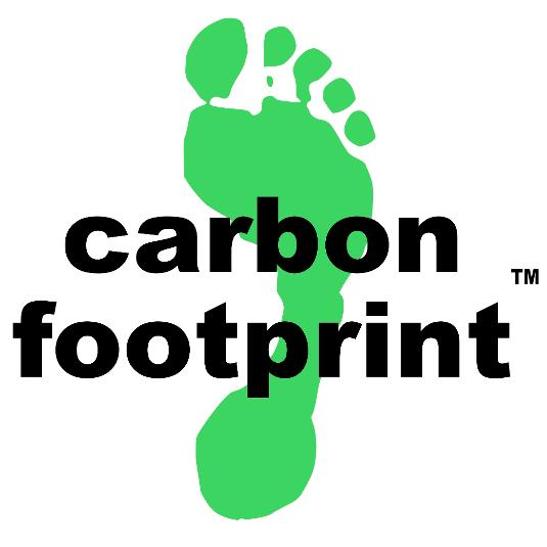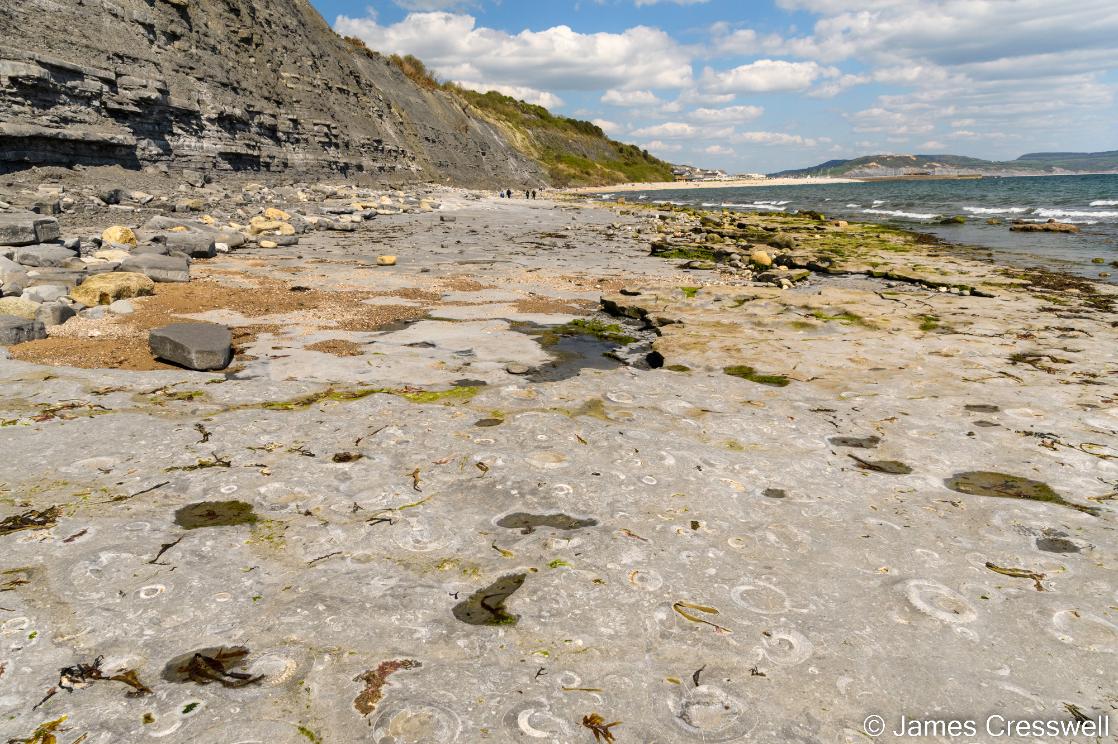England & Wales
Jurassic Coast & the Complete Geologic Timescale
london TO London
Exclusive small group tour, number of participants: 10-14
27 April - 9 May 2026 *FULL* - waitlist available
13 days/12 nights
£2,895
* * * * *
April/May 2027 (dates TBC)
13 days/12 nights
£TBC
Prices are per person, based on 2 people sharing a room. Single supplement applies, please make contact for details.
Price includes bed & breakfast accommodation, transportation, geological guiding and all entrance fees.
Includes the type Cambrian, Ordovician, Silurian, Devonian & Carboniferous areas
8 World Heritage Sites, 3 UNESCO Global Geoparks & 3 National Parks
and rocks from every (Phanerozoic) Geological Period
England and Wales are, together, one of the world's most geodiverse destinations, where is possible to see rocks of almost every geological time period. In fact, it is argued the area contains the world’s most geodiverse 10km grid square, which we visit on this tour. It is no wonder that the foundations of geological science were built both here and in neighbouring Scotland. The Cambrian, Ordovician, Silurian, Devonian & Carboniferous periods all have their type areas here . The area’s rich geology provided all the ingredients to give rise the Industrial Revolution, a legacy that we see at several locations. On this special trip you will have the chance to search for Jurassic fossils in Lyme Regis, Silurian fossils on Wenlock Edge and Ordovician trilobites in Mid Wales. You will see a Cretaceous dinosaur trackway, you will also descend a coal mine and a prehistoric copper mine. In addition, you will stand on the world’s first iron bridge, visit nineWorld Heritage Sites, three Geoparks and three National Parks. To top it all off, we will visit an outcrop from every period of geological time since the Precambrian!
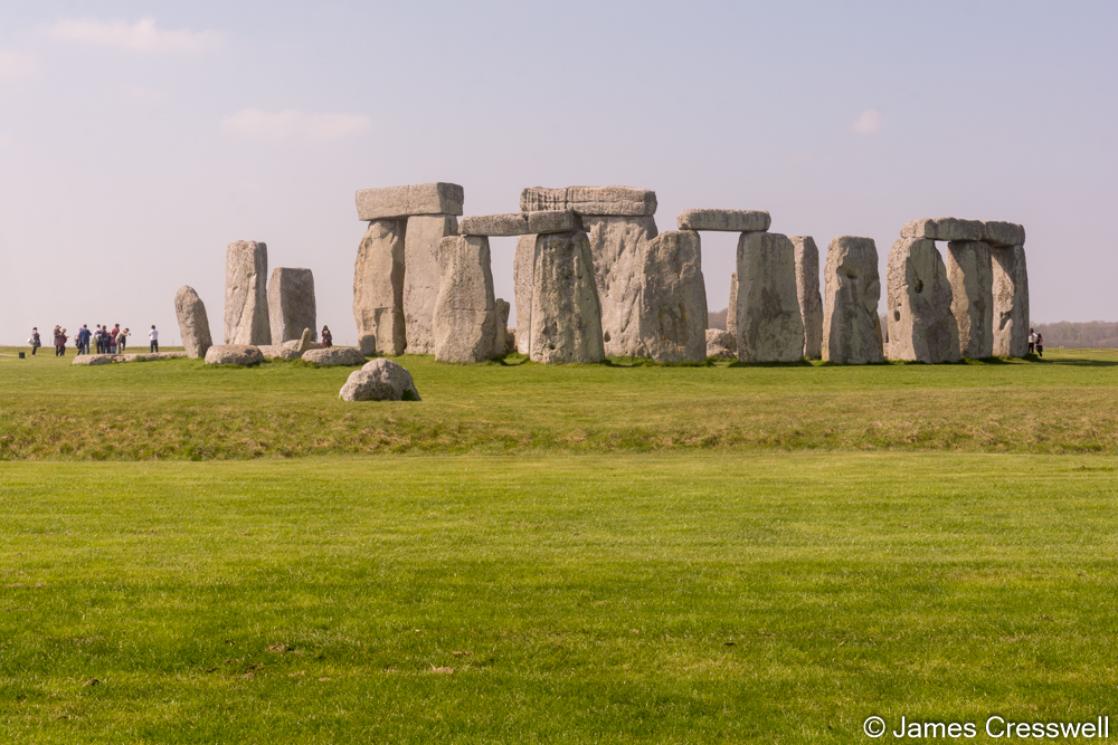
Stonehenge World Heritage Site (Day 2)
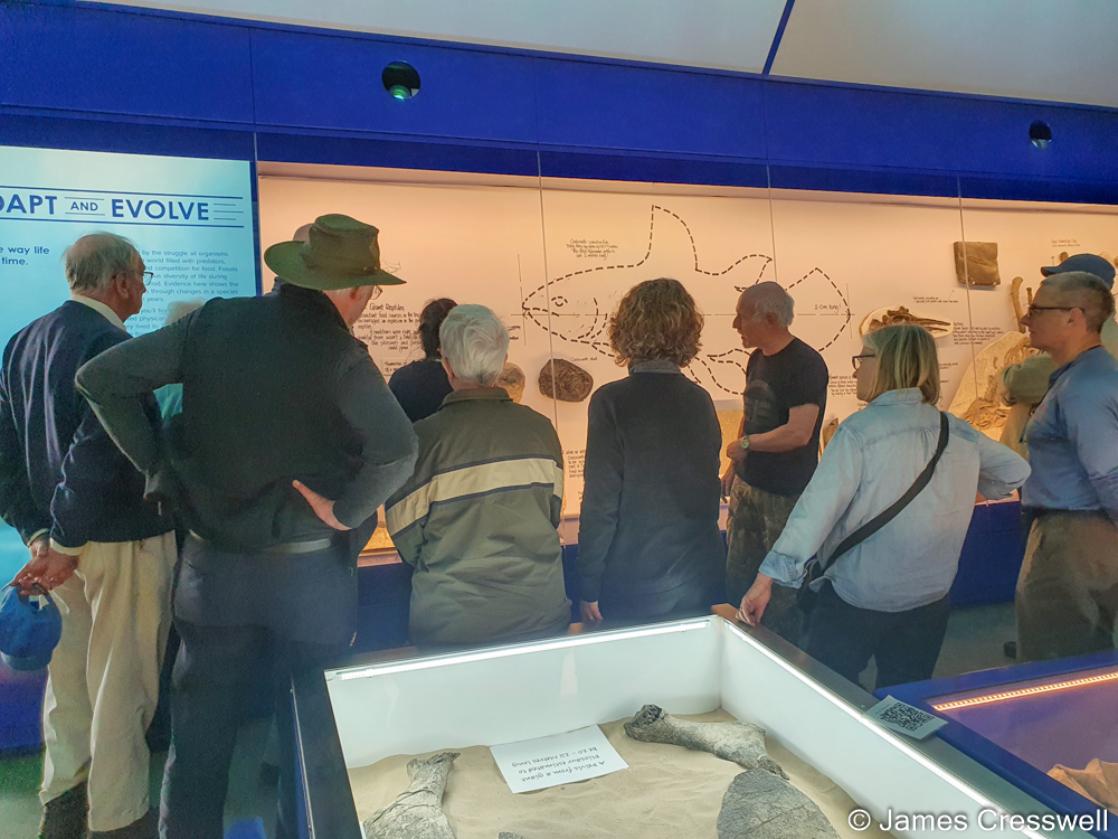
The Etches Collection museum on the Jurassic Coast (Day 2)
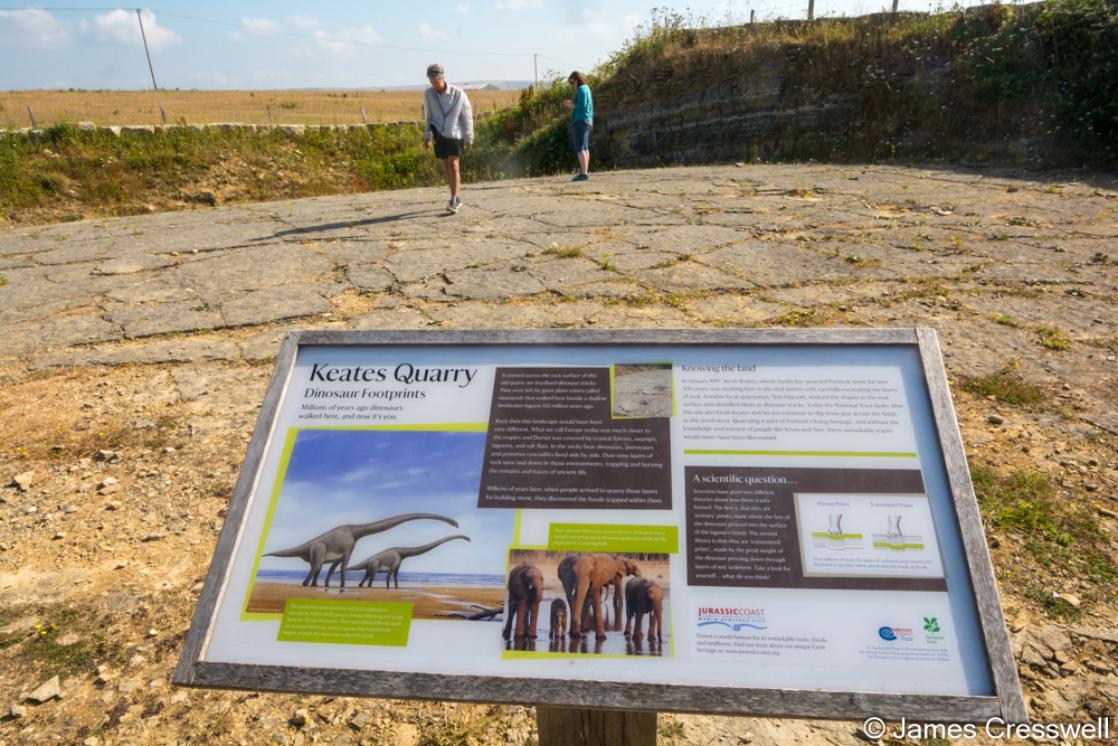
Keates Quarry sauropod dinosaur tracks on the Jurassic Coast(Day 2)
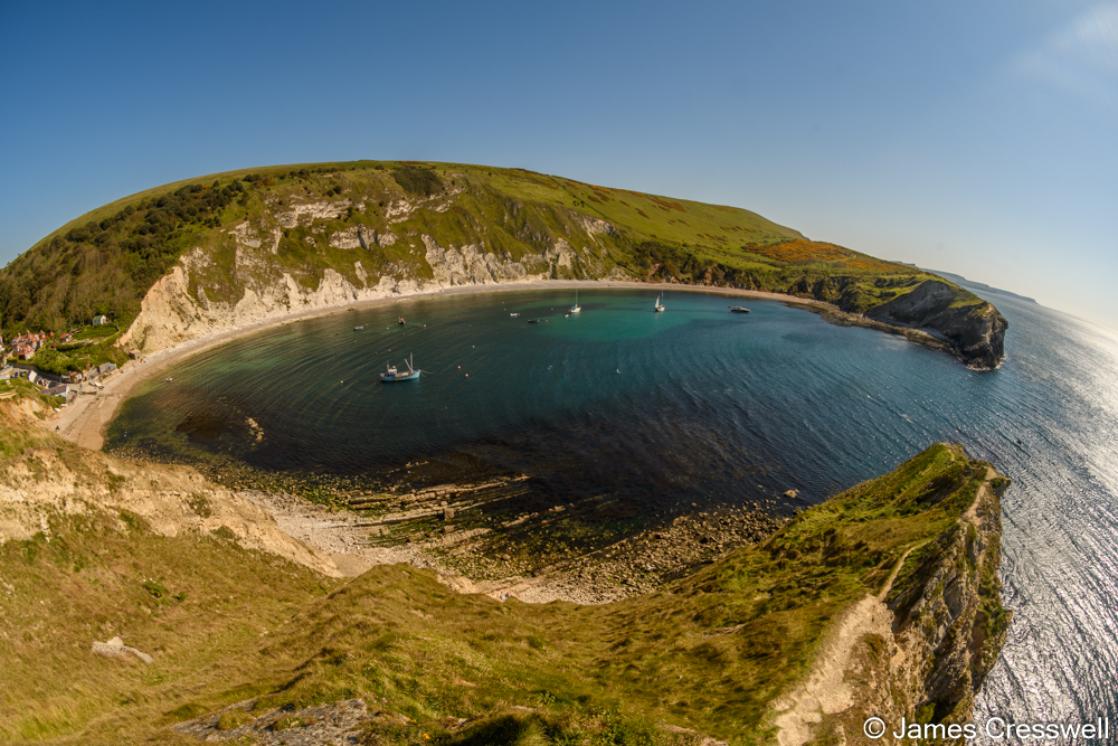
The perfectly round bay of Lulworth Cove on the Jurassic Coast (Day 3)
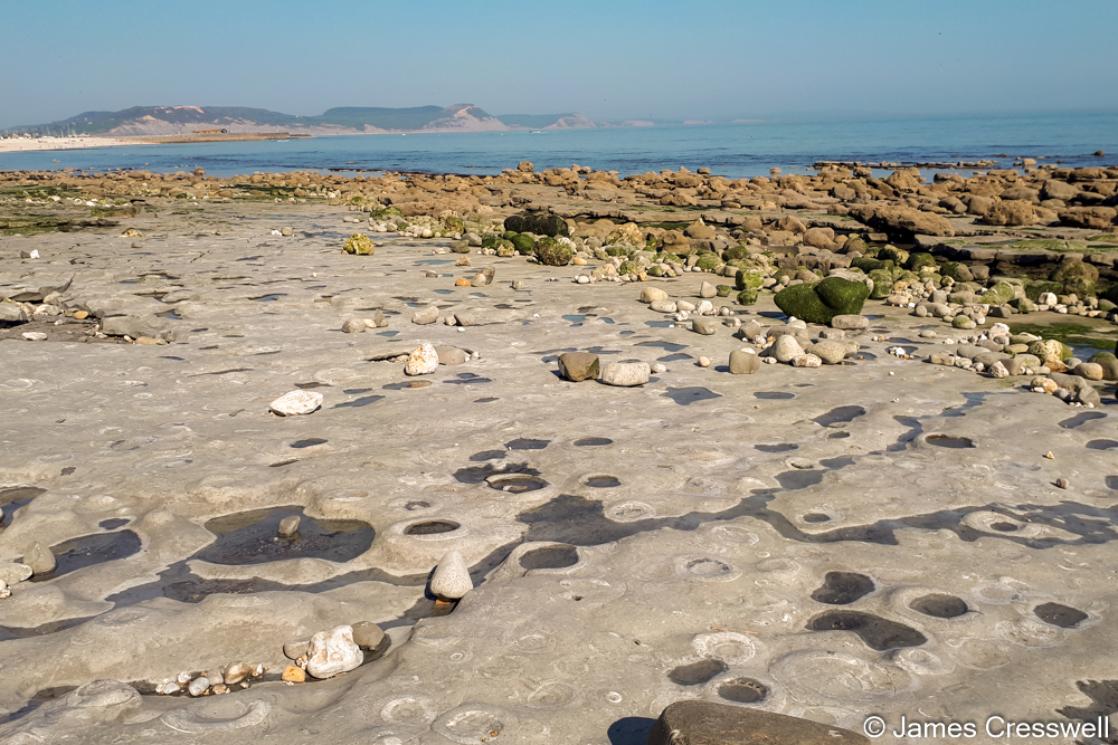
The ammonite graveyard on Monmouth Beach, Lyme Regis on the Jurassic Coast (Day 3)
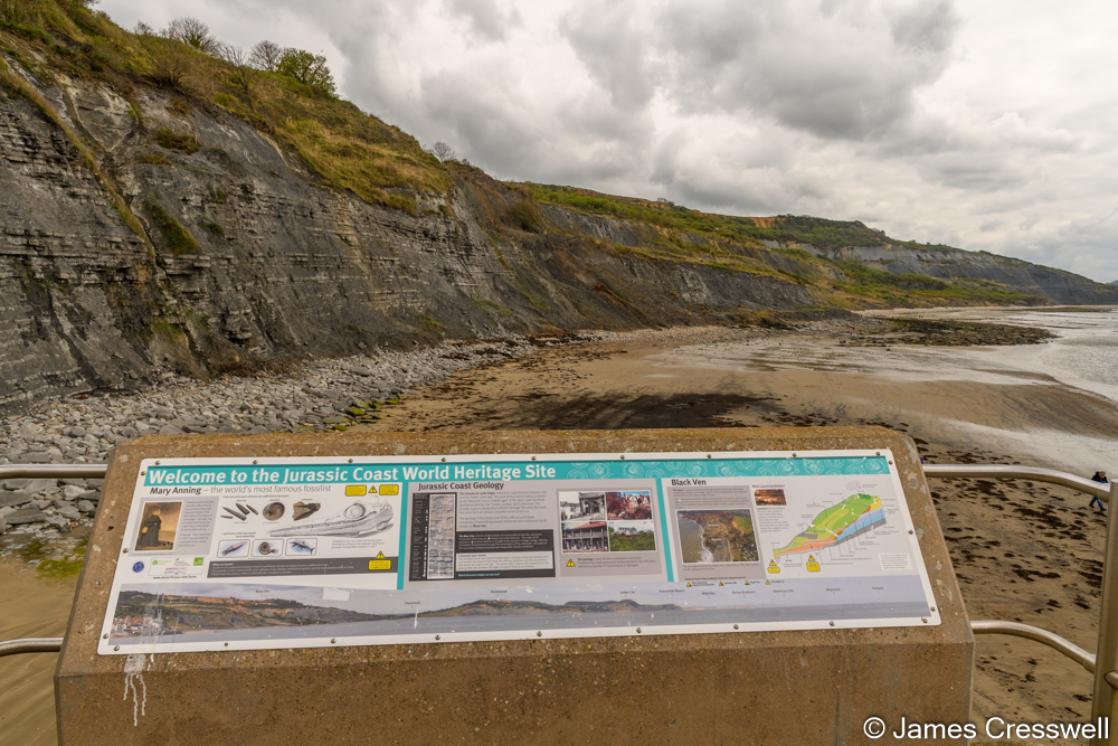
Lyme Regis Beach perhaps the most famous fossil beach in the world! On the Jurassic Coast (Day 4)
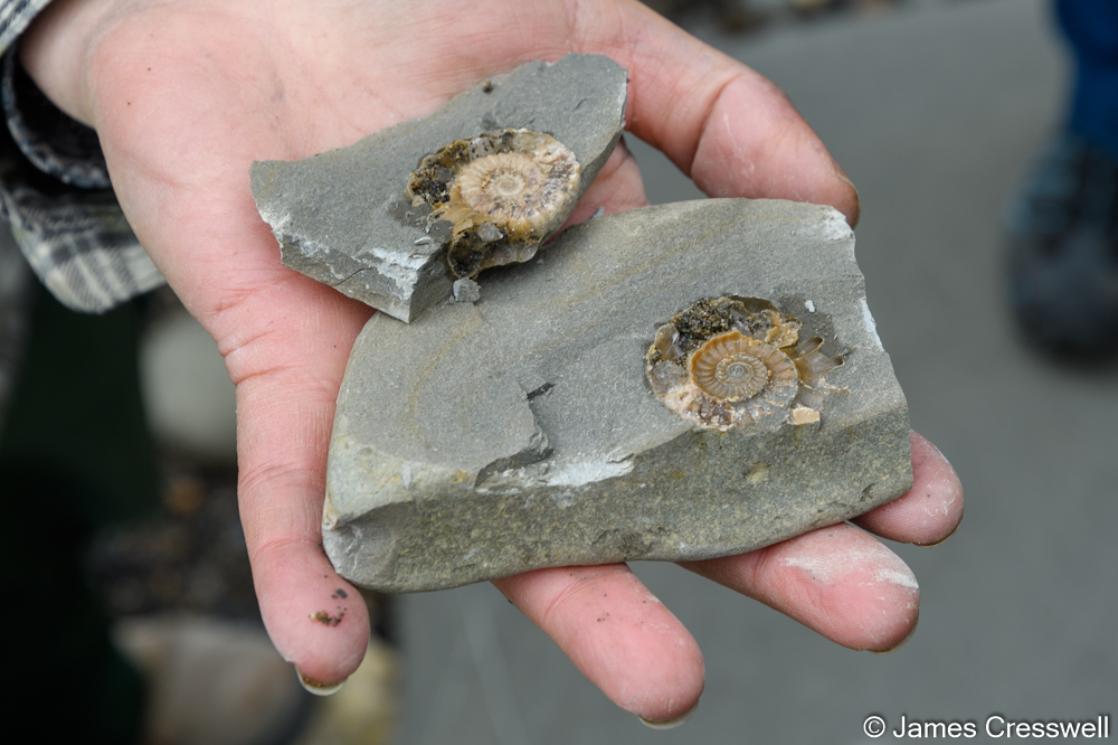
Cracking open a nodule to find an ammonite on Lyme Regis Beach (Day4)
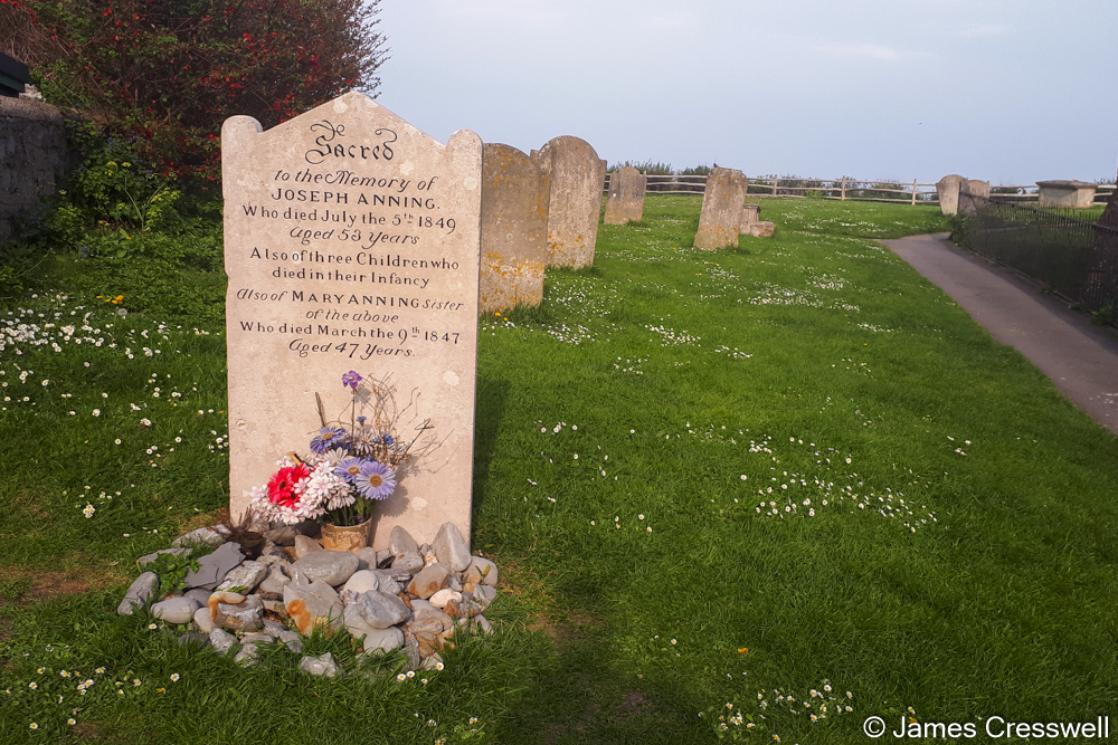
The grave of Mary Anning in Lyme Regis who is remembered as one of the greatest fossil discoverers ever to have lived (Day 4)
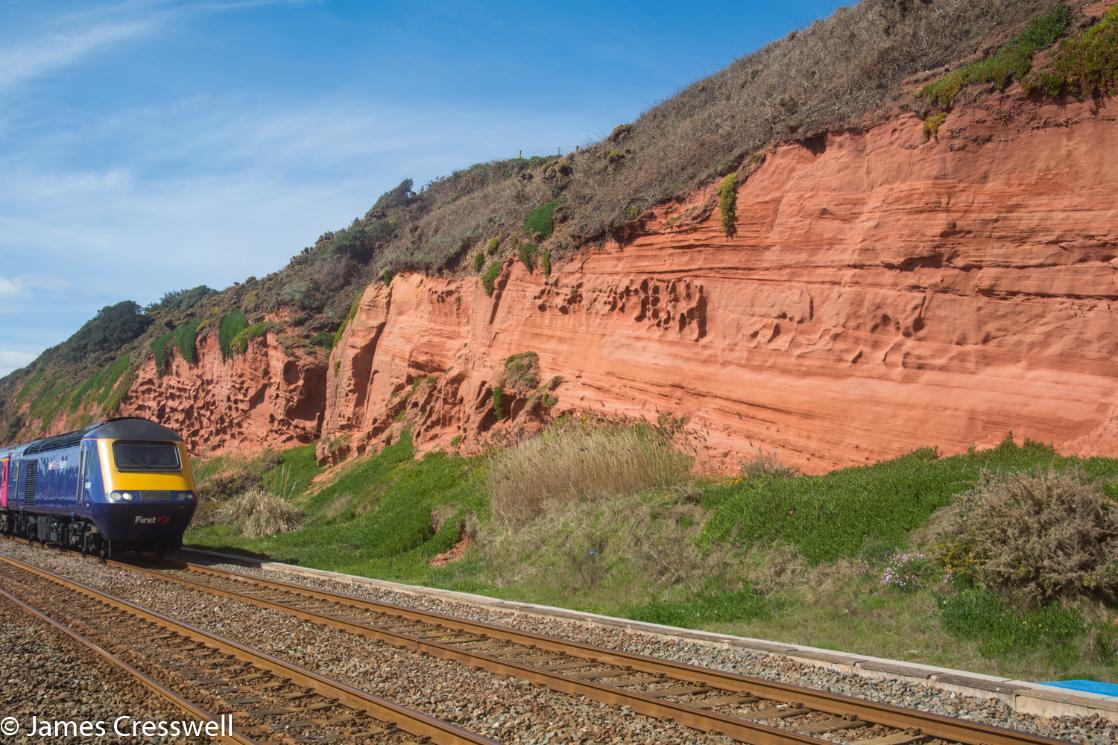
Permian aged fossilised desert dunes at Dawlish (Day 5)
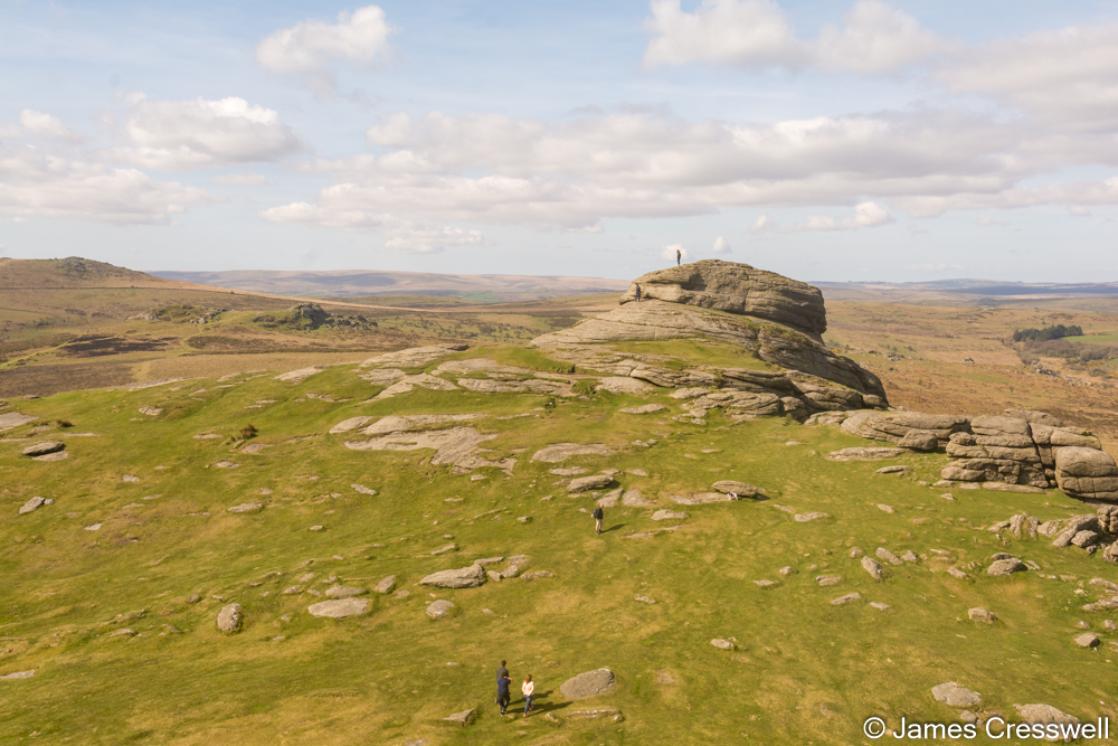
Hay Tor in Dartmoor National Park (Day 5)
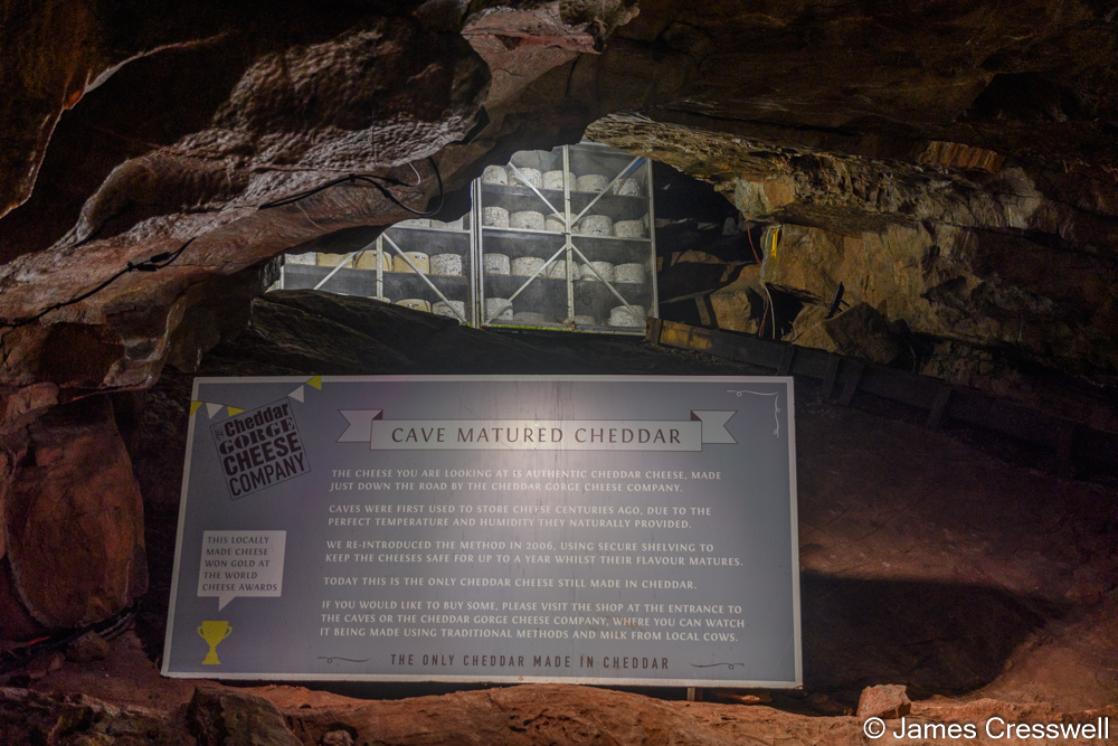
Cheddar Cheese maturing in Gough Cave in the village of Cheddar(Day 6)
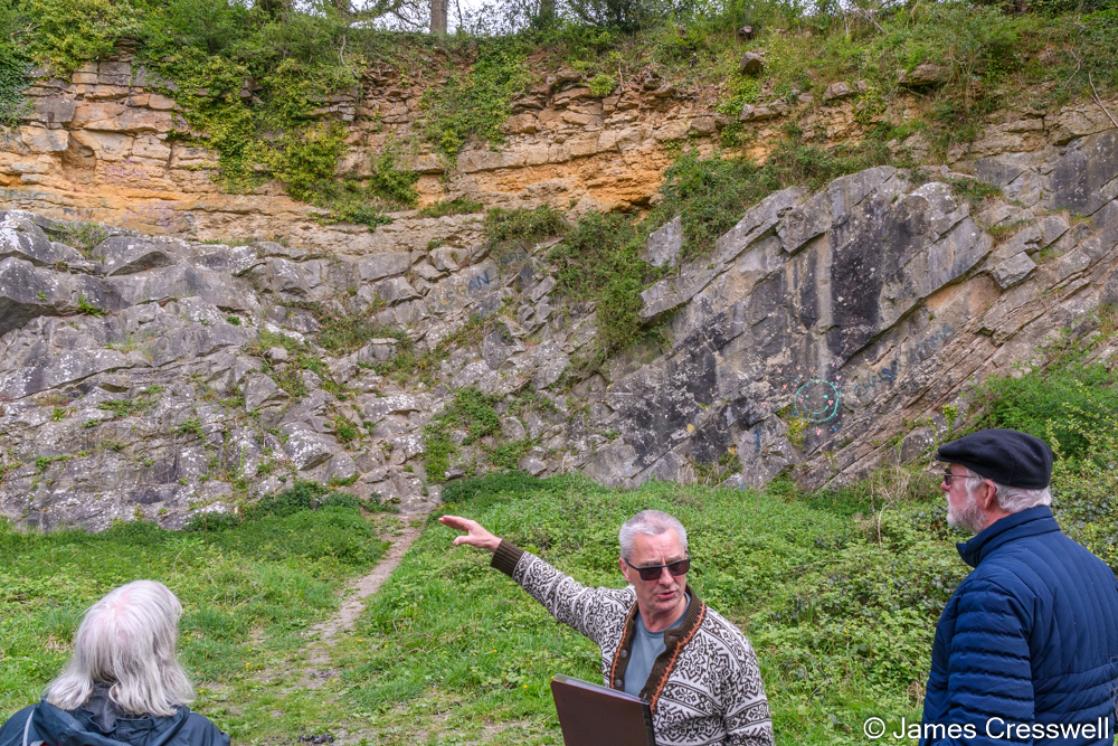
The De La Beche Unconformity at Vallis Vale here horizontal Jurassic strata lie on dipping Carboniferous strata (Day 6)
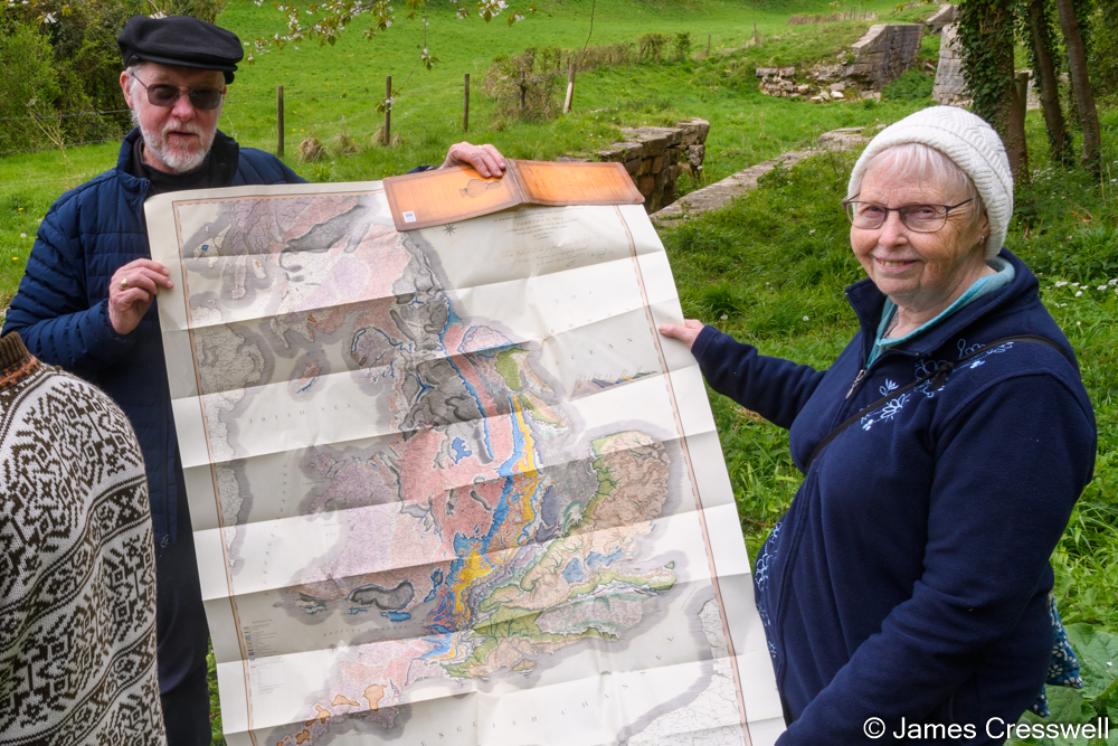
A copy of William Smith's 1815 geological map of England & Wales held up in front of locks he built in 1793, where he first noticed the strata dipped regularly eastward, like so many “slices of bread and butter.” (Day 6)
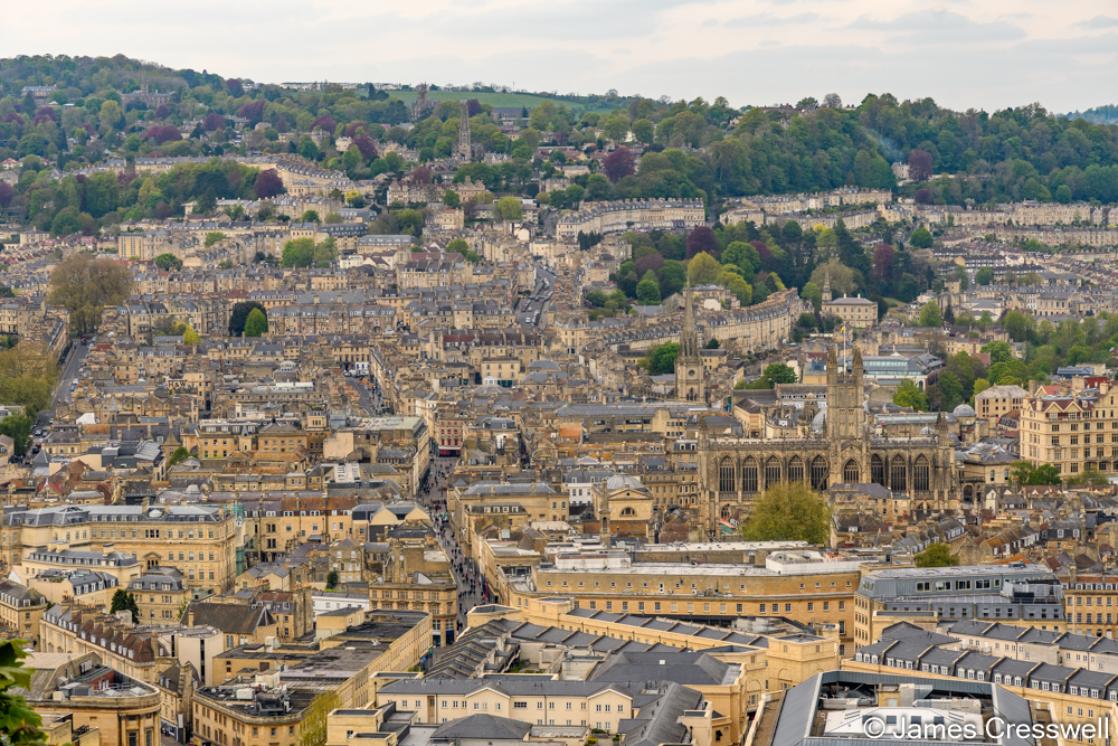
A view of the City of Bath which is a double nominated World Heritage Site, in both the City of Bath World Heritage Site and The Great Spa Towns of Europe World Heritage Site. It is also home to the Roman Baths, Britain's most important geothermal feature and was the place where William Smith famously dictated his ‘Table of Strata’, the first stratigraphic column, on 11th June 1799 (Day 6)
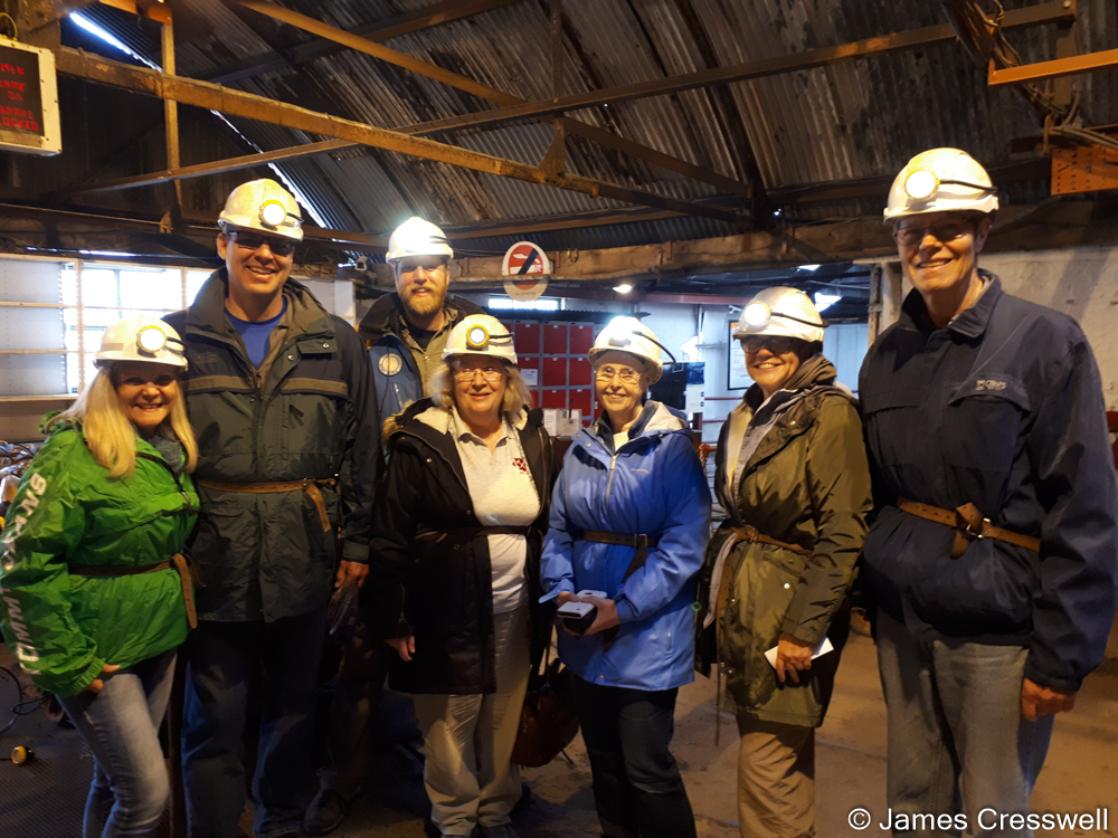
Our group in hard hats ready to descend the Big Pit in the Blaenavon World Heritage Site for an underground coal mine tour (Day 7)
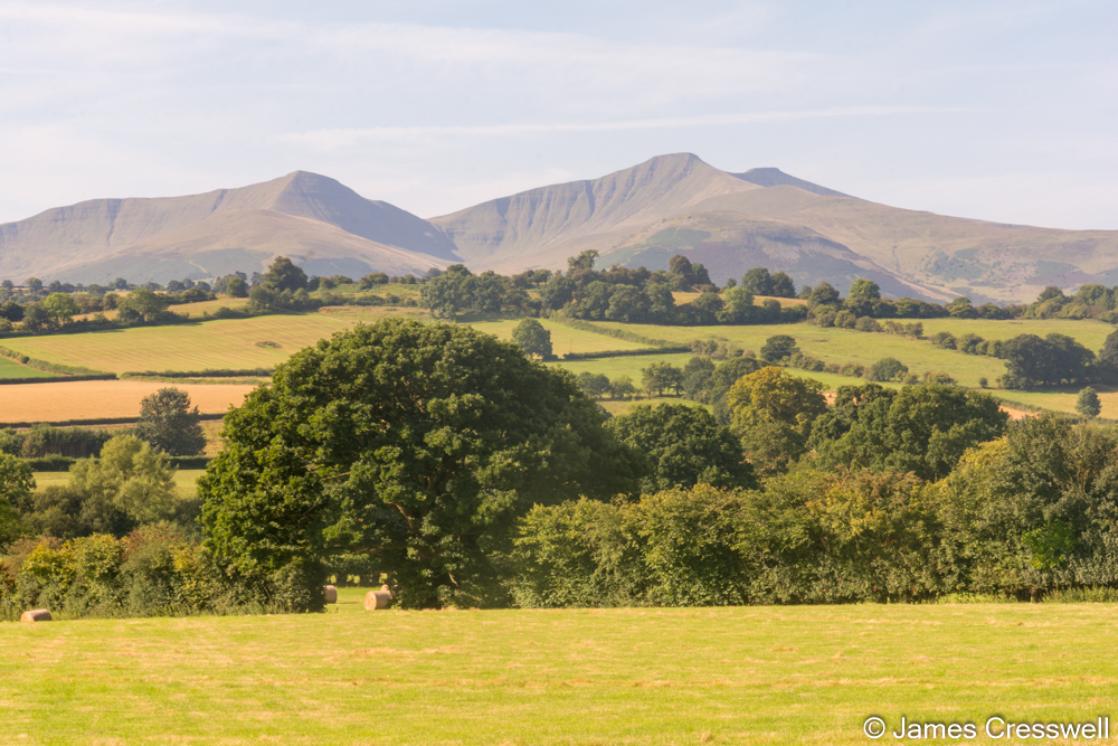
The Brecon Beacons in the Bannau Brycheiniog National Park & Fforest Fawr Geopark. These peaks are the highest in southern Britain and are made of Devonian aged Old Red Sandstone rocks (Day 7)
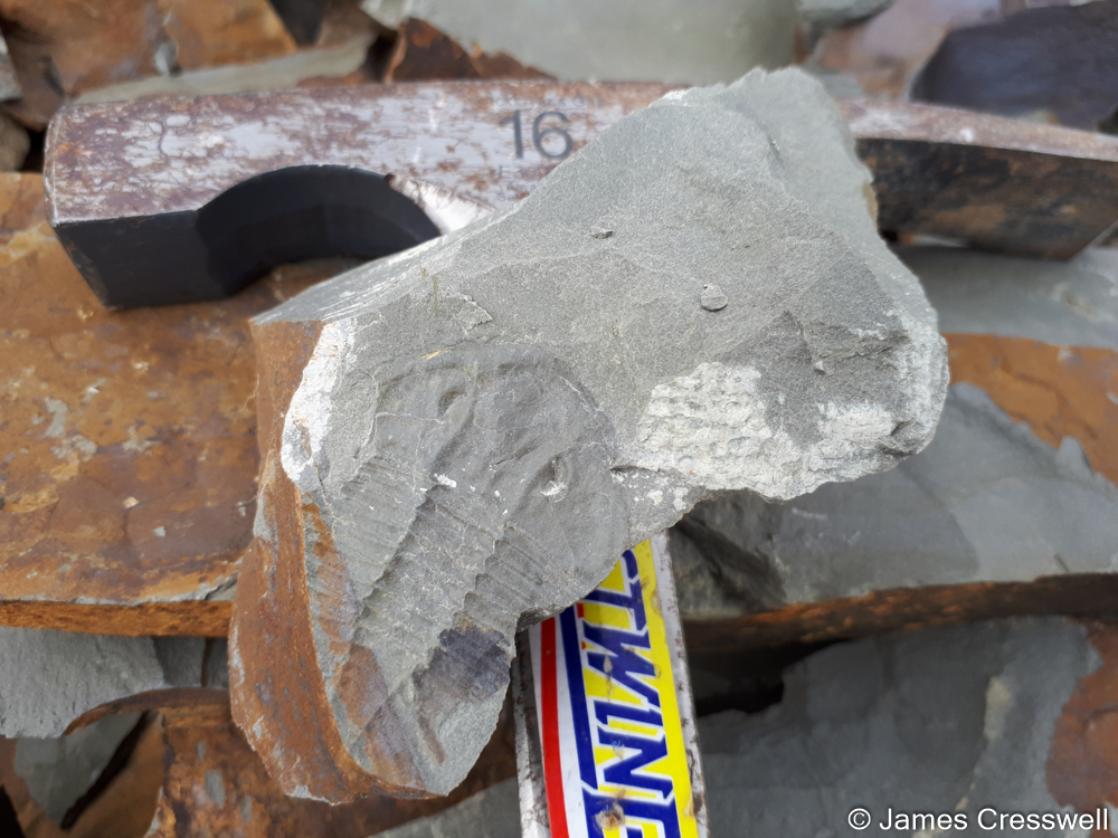
Find your own Ordovician trilobites near Llandrindod Wells (Day 8)
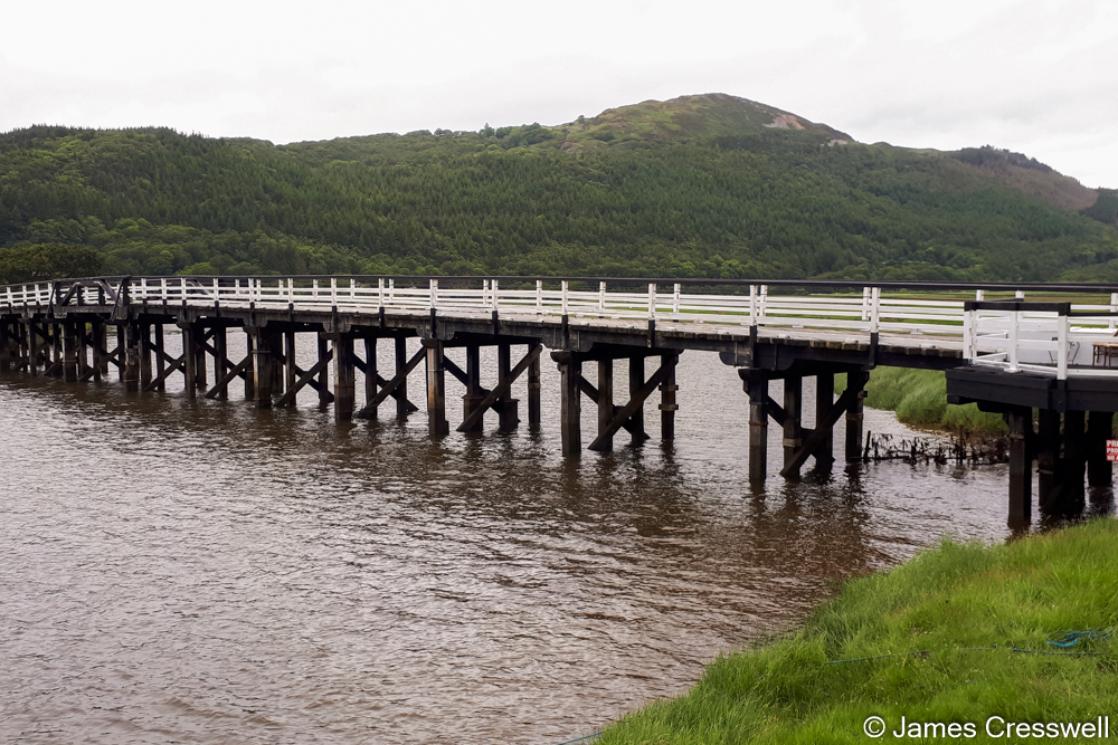
Penmaenpool toll bridge across the River Mawddach with Welsh gold mine spoil heaps on the mountain behind. The mountain behind is made of Cambrian strata of the Harlech Dome (Day 8)
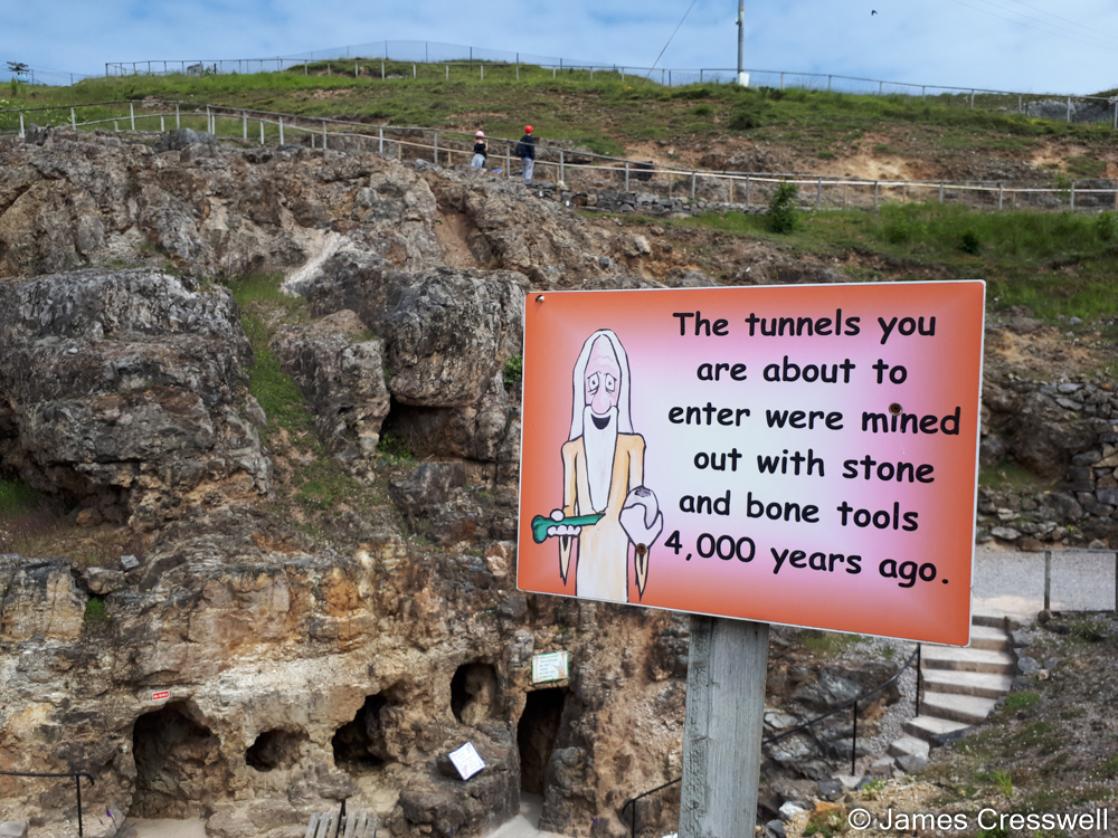
Great Orme, Bronze Age copper mine (Day 9)
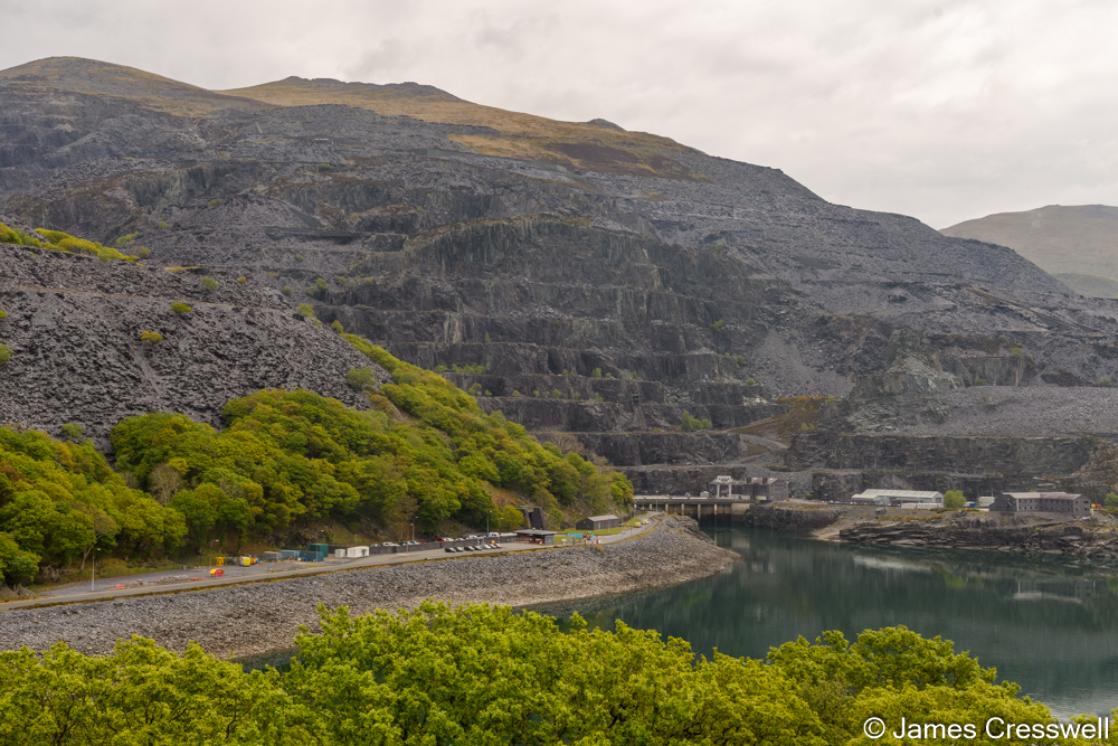
The Dinorwig Slate Mine in Slate Landscape of Northwest Wales World Heritage Site. The slates here are Cambrian in age and are in the type Cambrian area (Day 10)
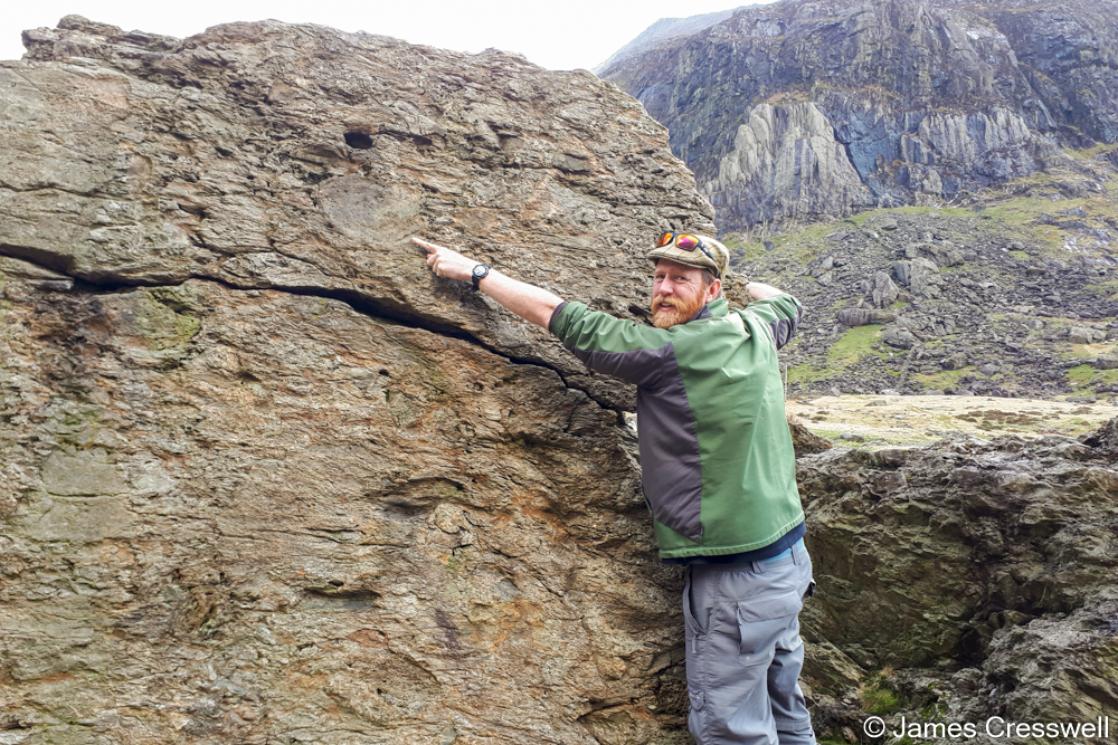
James Cresswell points to an Ordovician volcanic bomb in the Cromlech Boulders at the base of Snowdon (Day 10)
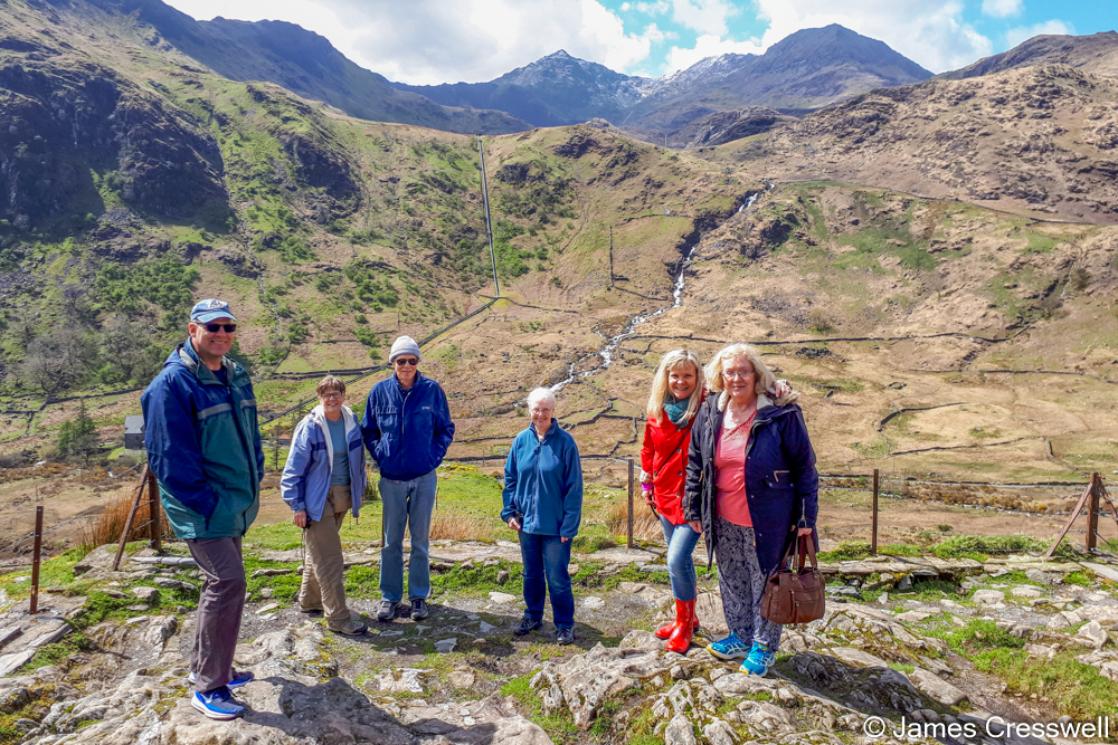
A GeoWorld Travel group standing infront of Snowdon, the highest mountain in England and Wales (Day 10)
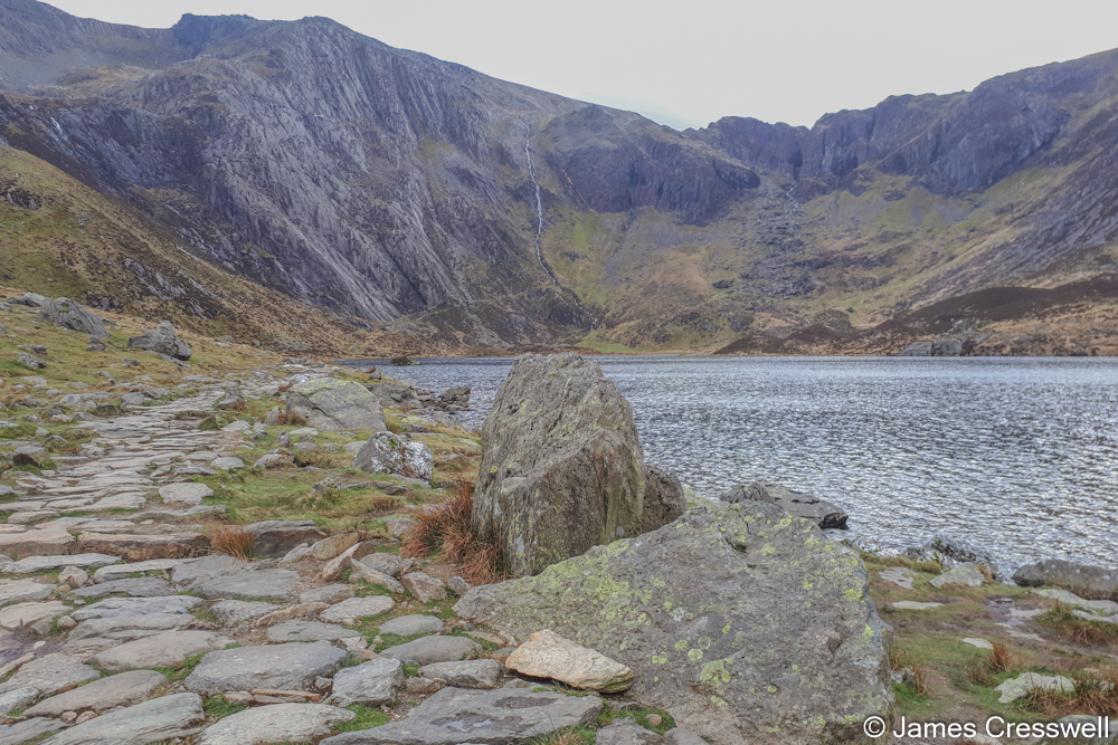
Darwin's Boulders in Cwm Idwal, Eryri (Snowdonia) National park (Day 10)
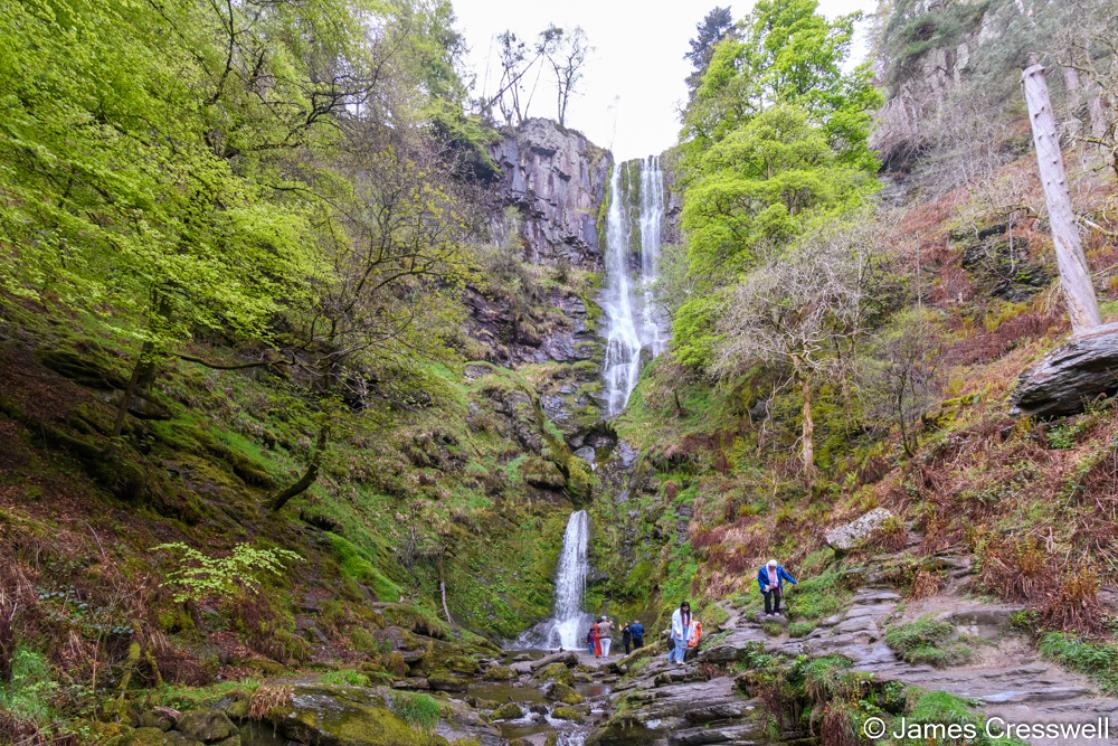
The highest waterfall in Wales: Pistyll Rhaedr, which flows over a hard band of Ordovician-aged tuff (Day 10)
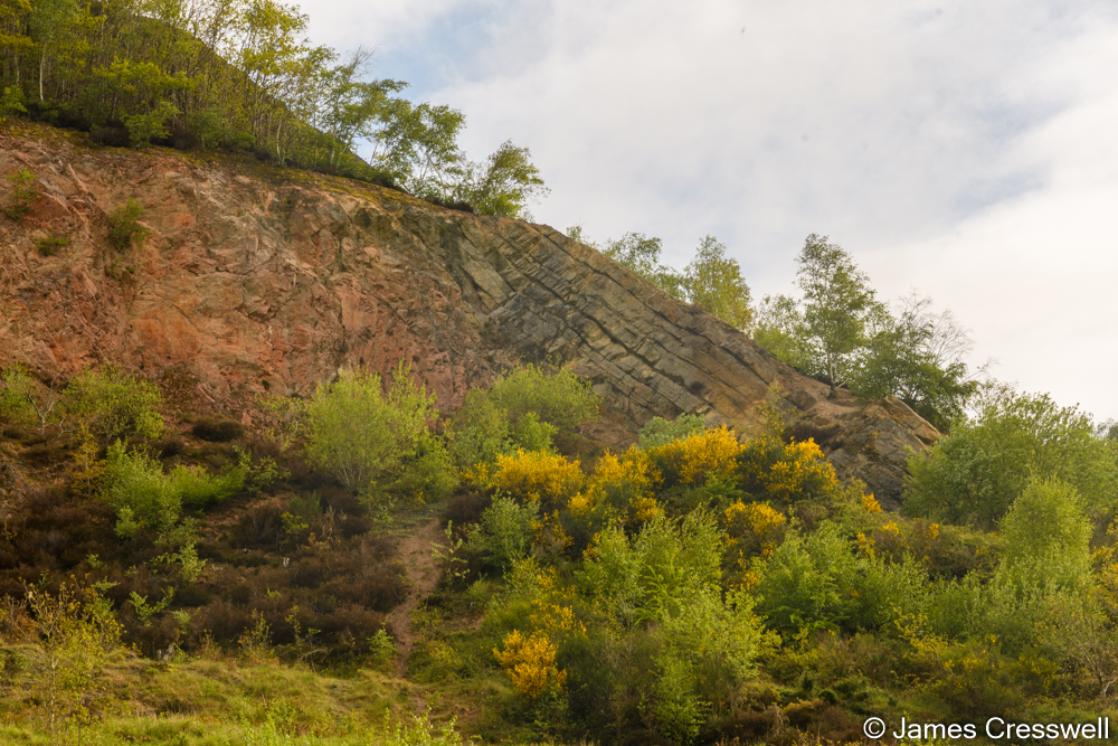
A Precambrian/ Cambrian unconformity in the Ercall Quarry at the base of The Wrekin, situated in the World's most geodiverse 10km grid square (Day 11)
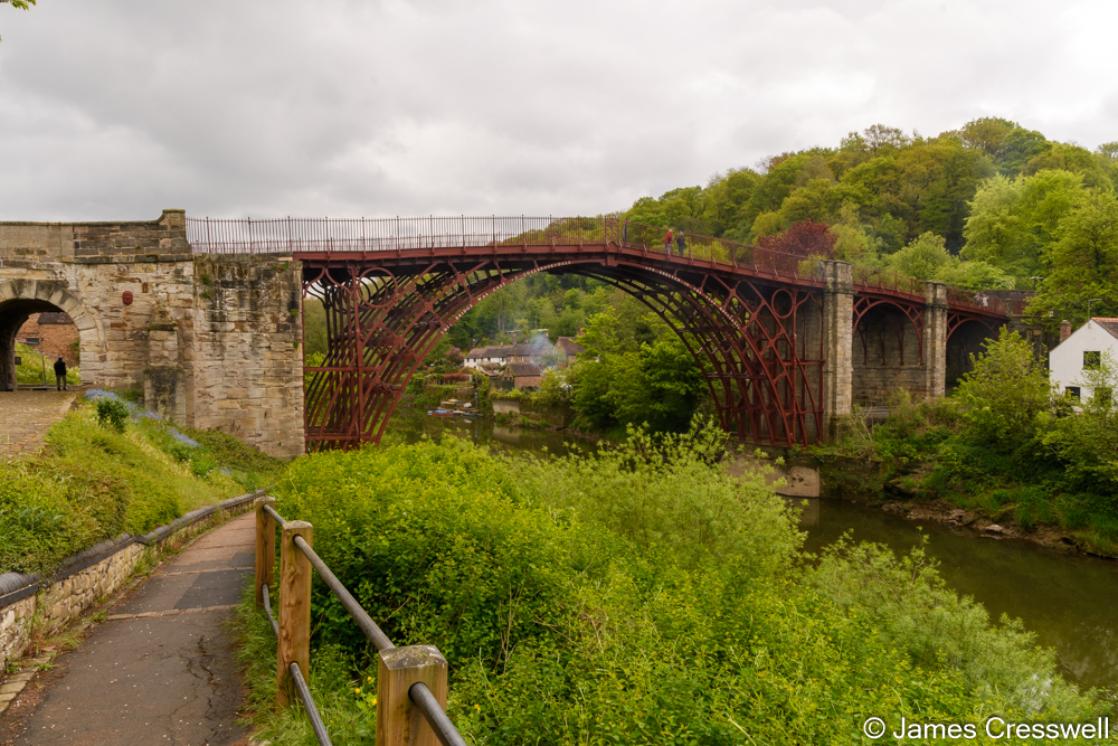
The world’s first iron bridge built in 1779, in the Ironbridge World Heritage Site and also in the World's most geodiverse 10km grid square (Day 11)
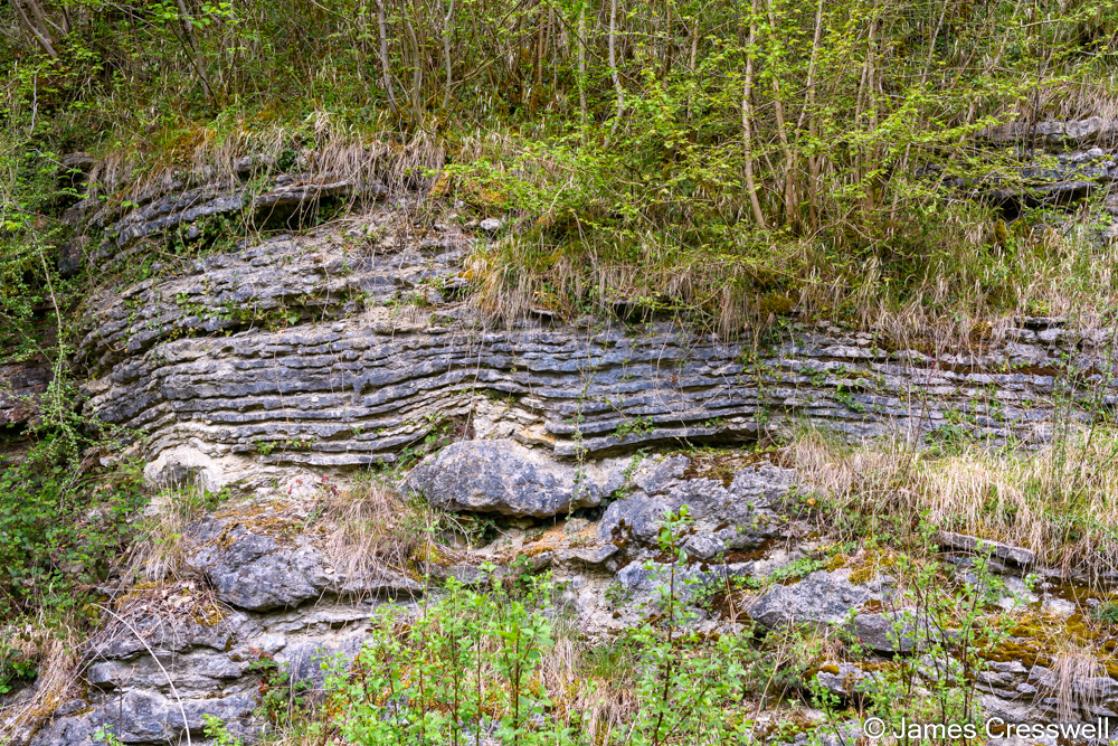
Bioherm reef and interbedded nodular, stratified and tabular Silurian limestones of the Wenlock Series, on Wenlock Edge (Day 11)
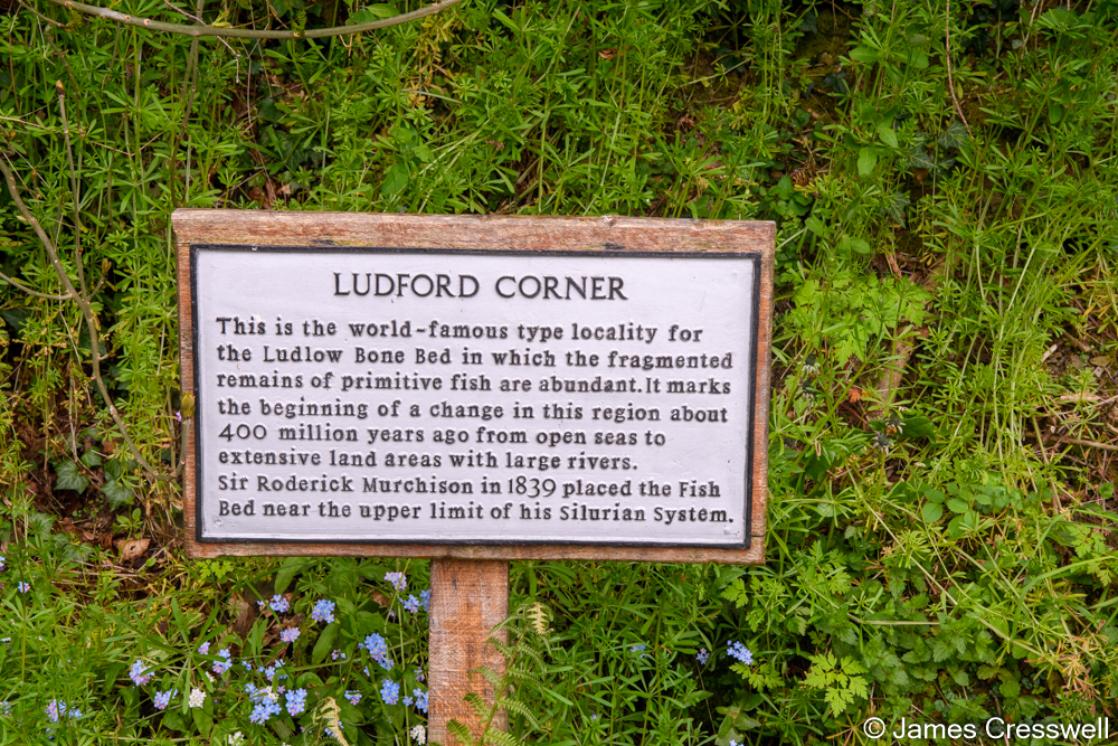
Ludford Corner in Ludlow, where the Ludlow Bone bed is exposed and Murchison originally placed the Silurian/ Devonian boundary (Day 12)
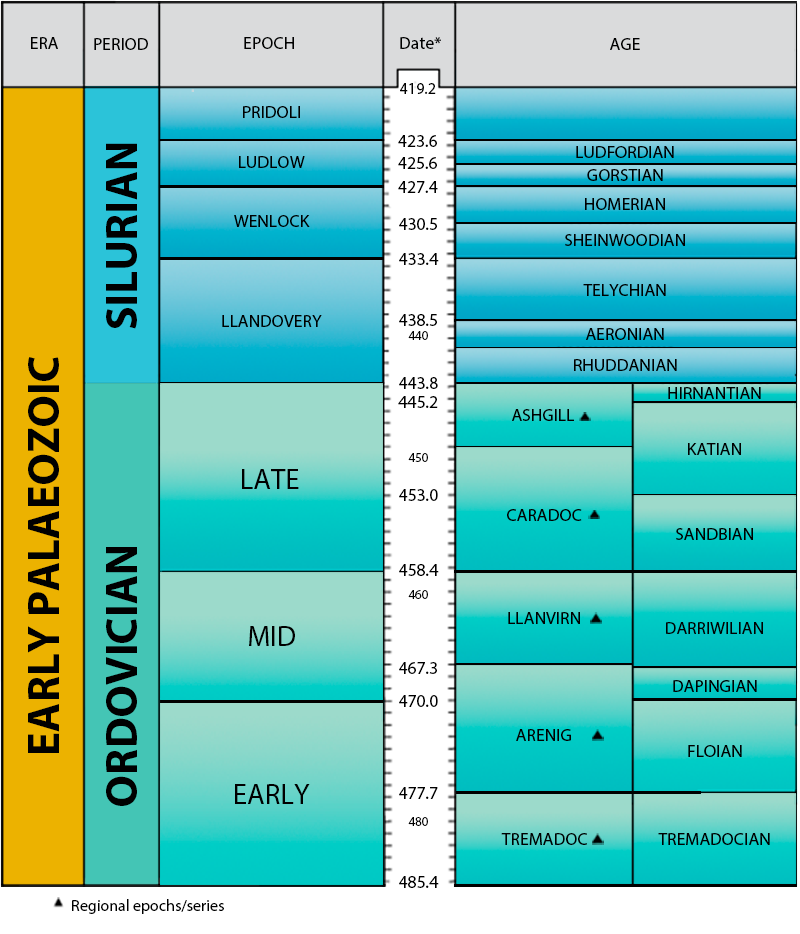
The Llandovery, Wenlock and Ludlow are internationally recognised epochs of the Silurian period and their type areas are in England & Wales. We observe Llandovery aged rocks near their type are on Day 8, Wenlock aged rocks in the their type are on Day 11 and Ludlow aged rocks in their type area on Day 12. We also visit the type areas of the Caradoc, Arenig & Tremadoc, which are British regional Ordovician epochs. Further more the international type areas of several ages (subdivisions within epochs) are visited such as the Kimmeridgian within the Upper Jurassic, the Tremadocian within the Lower Ordovician & the Ludfordian within the Ludlow.
Itinerary
Day 1 - Arrive in London. The group meets at a hotel close to London’s Heathrow Airport in the evening and we will spend our first night here.
Day 2 - Stonehenge World Heritage Site and The Isle of Purbeck in the Jurassic Coast World Heritage Site. In the morning we drive to Stonehenge World Heritage site, a prehistoric ring of standing stones set within earthworks. The inner stones, called the Bluestones, are Ordovician dolerite which come from the Preseli mountains in west Wales. The Altar Stone is from the Brecon Beacons, also in Wales and visited later in the trip. The large Sarsen stones were from a source local to Stonehenge. After lunch at Stonehenge, we drive to the Isle of Purbeck in the Jurassic Coast World Heritage Site. This island is not a true island but a peninsula. Our first stop is the incredible The Etches Collection Museum of Jurassic Marine Life, which contains over 2,000 specimens that were found in the Kimmeridge Clay - including the world's first known ammonite eggs! All the fossils in the museum were found by Steve Etches MBE on nearby Kimmeridge Beach and, depending on his availability, we hope that Steve will meet us and give a personalised museum tour. We then visit the beach which lends its name to both the Kimmeridgian stage of the Upper Jurassic and to the Kimmeridge clay which has yielded many important fossils and is the source rock for North Sea oil. Our hotel is in a rural location with fine views of the magnificent Corfe Castle.
Day 3 – Lulworth Cove & Lyme Regis in the Jurassic Coast World Heritage Site. Our first stop is a sauropod dinosaur trackway, made by Brachiosaur-like dinosaurs wading in an early Cretaceous lagoon. The next stop is a site called Redcliff Point where we will see some Paleogene aged sandstone which would have formed in estuarine conditions. We then move on to see the famous Lulworth Cove. The highlight here is a continuous 80-million-year record of sedimentary layers from late Jurassic Portland Limestone to late Cretaceous Chalk. The layers are vertical due to a large monocline fold, best seen in the Lulworth Crumple, and because the layers are an alternating sequence of hard and soft rocks, the sea has eroded them in differing amounts creating the perfect circular bay of Lulworth Cove. We then proceed onwards stopping at a viewpoint above Chesil Beach, Britain's longest barrier beach, which is famous for the systematic-size grading of pebbles and cobbles along its beach. Our final stop is Monmouth Beach in Lyme Regis where we will spend the remainder of the afternoon (dependent on the tides), viewing giant ammonites and the ‘ammonite pavement’, before checking into our Lyme Regis hotel for the next 2 nights.
Day 4 – Lyme Regis on the Jurassic Coast World Heritage Site. The whole day is spent in Lyme Regis and on its fossiling beaches. The order of events is dependent on the tides, but we could start the day with free time, a chance to browse the fossil shops and visit both the Dinosaur Land Fossil Museum and the Lyme Regis Museum. The Lyme Regis Museum was once the home of Lyme Regis's most famous daughter, Mary Anning, who has been described as 'the greatest fossilist the world ever knew’ and, depending on availability, we might have a guided tour of the museum with one of its staff. After lunch in the town, we could then spend the afternoon walking the beach from Lyme Regis to Charmouth. This walk is only two miles long in total and depending on availability we may be joined by the staff member from Lyme Regis Museum, who can give additional local knowledge. This beach is perhaps the most famous fossil beach in the world! It is here that Mary Anning, found her famous ichthyosaur and plesiosaur fossils. We will scour the same beach, searching for our own fossils. The rocks that make up the cliffs are Lower Jurassic in age. Ammonites and belemnites are the most common find but, with some luck, ichthyosaur bones can occasionally be found. We will then spend a second night in Lyme Regis.
Day 5 – The New Red Sandstone, The Great Devonian Controversy, and Tors & Tin mines in Dartmoor National Park. The day is spent in the county of Devon after which the Devonian period was named. Our first stop is in Devon but still within the Jurassic Coast WHS - Sidmouth. Here we see bright red Triassic aged sandstones that also form impressive cliffs. These Triassic rocks along with older Permian rocks are known as the New Red Sandstone. Otter Sandstone is one of the richest sources of Triassic reptile fossils in Britain and we can see examples of these in the Sidmouth Museum, our next stop. We then move on to Dawlish to see spectacularly preserved Permian-aged fossil desert dunes in the cliffs. The next stop is in Torquay in the English Riviera Geopark to see Devonian-aged rocks in their type area of Devon. At Triangle Point we see abundant stromatoporoids and corals, goniatites and gastropods are also present. Fossils found here and elsewhere in south Devon are marine and Murchison originally believed they must be Silurian. However when he later found similar fossils in Russia and it was shown that some rocks in northwest Devon contained Carboniferous fossils, he realised that the marine rocks of south Devon rocks are the same age as the terrestrial Old Red Sandstone rocks seen elsewhere in Britain. It was this realisation that led to Sedgwick and Murchison established the Devonian System in 1839. Additionally at Triangle Point we see a recumberant anticline and the site where small amounts of gold were once extracted. We then continue to Dartmoor National Park stopping at the park’s most iconic tor: Hay Tor. The rock that forms the tor is Permain-aged granite that was intruded as part of a great batholith during the Variscan Orogeny. The tors themselves formed as a result of Ice Age and ongoing erosional processes. A mile to the west of the tor is the site of Haytor Consols tin mine and we make a brief stop here. Although there is now very little to see at Haytor Consols it is still a good place to tell the story of Devon & Cornwall’s tin mines. Tin has been hugely important in the history of Britain. Incredibly, as long ago as four thousand years ago, the Phoenicians travelled to Cornwall to obtain tin, and its presence was one of the main reasons for the Roman invasion of Britain some 2,000 years later. The mines a little further to the west of this site have been designated as the Cornish Mining World Heritage Site. We spend the night in the town of Taunton in the county of Somerset.
Day 6 – Cheddar, William Smith’s Order of the Strata, and Bath’s World Heritage Sites. The first stop is the famous village of Cheddar, where the cheese originates! Here we visit Gough's Cave, a beautiful show cave with stalactites, stalagmites, flowstones, and maturing cheese. It is also the discovery site of Britain's oldest complete human skeleton: Cheddar Man, which is about 9,100 years old. We also drive through the spectacular Cheddar Gorge, which is cut into Carboniferous limestone, via the Mendip Hills and Somerset Coalfield to reach the famous 'De La Beche' unconformity, at Vallis Vale. The unconformity was described in the world's first Geological Survey memoir in 1846. Here, an old quarry clearly shows the unconformity between the yellow coloured, horizontally bedded Mid Jurassic Inferior Oolite limestone and the underlying grey, massively bedded and steeply dipping Carboniferous Limestone. Our next stop is the abandoned locks on the former Somerset Coal Canal, at Combe Hay. This canal was built by William Smith, known as the ‘Father of English Geology’. While surveying for the canal in 1793 he noticed the strata dipped regularly eastward, like so many “slices of bread and butter.” He later found this to be true over much of England and in 1799 published a geological map of Bath: the first known British geological map. This was followed in 1815 by his monumental Delineation of the Strata of England and Wales in which he published his great geologic map of England and Wales. The next stop is a plaque on a house next door to Smith’s former residence at Tucking Mill. Our then journey then takes us to an overview of the City of Bath. The city has two UNESCO World Heritage Site designations, one for its Georgian architecture and the other for the Roman Baths which are Britain’s best geothermal feature. We then drive into the city to see a plaque dedicated to William Smith on Great Pultney Street, where he dictated his ‘Table of Strata’, the first stratigraphic column, on 11th June 1799. We then drive on, leaving Somerset and England, crossing the Severn Estuary (which has the second highest tide range in the world), via the Prince of Wales Bridge to reach Abergavenny. The town is situated at the edge of the Bannau Brycheiniog (Brecon Beacons) National Park in Wales, and we spend the night here.
Day 7 – Type Carboniferous rocks in the Blaenavon World Heritage Site, The Fforest Fawr Geopark & Murchison’s First True Siluria. We start the day by driving up the Clydach Gorge, situated within the Bannau Brycheiniog (Brecon Beacons) National Park, passing through the four ‘type’ divisions of William Philips & William Conybeare’s Carboniferous System, established in 1822. The type area for the Carboniferous was all the coalfields of Britain and our first stop of the day at Brynmawr is in Britain’s biggest coalfield: the South Wales Coalfield. Here we can see the Coal Measures with their coal seams and ironstones. We then continue to the Blaenavon Industrial Landscape UNSECO World Heritage Site, where we visit the Blaenavon Ironworks. This is the place where, in 1878, the Gilchrist-Thomas process was invented that allowed steel to be produced from phosphorous iron ore, enabling the Industrial Revolution to begin around the world (James’s great-great-grandfather was the General Manager here when this breakthrough was made!) The ironworks are situated here because the local geology provided the coal, ironstone and limestone needed. Our next stop is the Big Pit coal mine and we join a fascinating underground tour led by former miners, visit a simulated underground mine and a mining/geology museum. After this, we go to Garnddyrys Forge, which lies on the old tramroad from the Ironworks to the Brecon and Monmouthshire Canal and, in fact, used to produce tram rails. The site also has magnificent views of the local geology and Bannau Brycheiniog (Brecon Beacons) National Park and lies directly above Ogof Draenen, the second longest cave in Great Britain. Our interest now moves on to the Devonian-aged Old Red Sandstone and dramatic scenery of the National Park. We first visit a Neolithic standing stone known as The Growing Stone; this is made from the Senni Formation of the Old Red Sandstone and is lithologically exactly the same as the Altar Stone of Stonehenge. This lends weight to the idea that the Bluestones, now proved to have originated in West Wales, passed overland to reach Wiltshire, passing right by the place where the Growing Stone stands today. To get a better understanding of how the Old Red Sandstone formed, we stop at Tremynfa Quarry where we see beautiful examples of fossilised river channels. We then enter the Fforest Fawr UNESCO Global Geopark, which is also within the Bannau Brycheiniog (Brecon Beacons) National Park, and stop at a magnificent viewpoint, on Mynydd Illtyd, where all four mountain ranges of the Bannau Brycheiniog (Brecon Beacons) National Park can be seen. These mountain ranges are the type area of the Old Red Sandstone and were first described geologically by Sir Roderick Murchison in 1831. Our final stop of the day is another location visited by Murchison and came to be regarded by him as his ‘First True Siluria’. The site is on the River Wye, where Old Red Sandstone rocks give way to greywacke rocks, and it is here that Murchison first decided that there was sufficient evidence to enable him to make a systematic study of the greywacke rocks which was to culminate in the publication of ‘The Silurian System’ in 1839. The night is spent in the Mid Wales town of Llandrindod Wells which in Victorian times was famed for its chalybeate springs.
Day 8 – Ordovician Trilobites, metal mines, and the Harlech Dome type Cambrian area. Our first stop of the day is the Lower Gilwern Trilobite Quarry, this site is the best place in Great Britain to find trilobites! We spend several hours here finding and collecting our own fossils - a real highlight of the tour! We then drive to the beautiful Elan Valley where we stop to observe Llandovery aged rocks, which are better exposed here than in their type area 16 miles away. (The Llandovery epoch is an internationally recognised subdivision of the Silurian period and is named after the Welsh town Llandovery). We then proceed via the Elan Valley’s scenic Victorian dams to reach Cwmystwyth, where lead was mined from the Bronze Age until the early 20th century, here it is possible to find our own samples of galena and chalcopyrite. Cwmystwyth is part of the Central Wales Ore Field where copper, lead and silver were mined. We then then continue north and enter the Eryri (Snowdonia) National Park. As we drive, we have magnificent views of Cadair Idris mountain which is made from an erosion resistant Ordovician granophyre sill. On the northern side of Cadair Idris, on the banks of the Afon Mawddach, we stop to view (from a distance) the famous Clogau gold mine which is high on the hill above. The mine is currently inactive but has, for over 100 years, been the source of the gold for the British Royal Family, and jewellery containing Welsh gold is still very much sought after. The gold is in a quartz vein named the “St. David’s Lode” which cuts through Cambrian aged sediments of the Harlech Dome. These Cambrian rocks have a further interest as they, along with other Cambrian-aged rocks in North Wales, were the first identified Cambrian-aged rocks anywhere in the world. In 1835 Adam Sedgwick proposed placing them in the Cambrian “Series” (later known as the Cambrian Period), which he named after Cambria, the Latin name for Wales. Our journey then continues through the Cambrian-aged rocks of the Harlech Dome pausing in Barmouth for an overview of lower Cambrian stratigraphy before stopping at Harlech Beach, whose sands of rest on Neogene bedrock. Here we also have magnificent views of Harlech Castle part of the ‘Castles and Town Walls of King Edward in Gwynedd World Heritage Site’. Our route then passes through the type area of the Tremadocian stage of the lower Ordovician and the village of Tremadog, before arriving at Caernarfon where we spend the next two nights.
Day 9 - The Great Orme Prehistoric Copper Mine, GeoMôn UNESCO Global Geopark, Eryri (Snowdonia) National Park, and the Castles and Town Walls of King Edward in Gwynedd World Heritage Site. Our first stop of the day is the Great Orme prehistoric Copper Mine. Here we can descend into the mine shafts that were carved out by Bronze Age workers 4,000 years ago. We then drive around the Great Orme headland observing its Carboniferous limestone and dolomite layers. The next stop is a short walk to a viewpoint of Conwy Castle also part of the ‘Castles and Town Walls of King Edward in Gwynedd World Heritage Site’, before crossing over the sea on the world’s oldest suspension bridge to reach the Isle of Anglesey. The whole island has been designated a UNESCO global geopark, the GeoMôn Geopark. The first stop is Llanfairpwllgwyngyllgogerychwyrndrobwyllllantysiliogogogoch, the second longest one-word place name in the world! Here we visit the famous train station with place name sign and gift shop. Also visible in Llanfair P.G. are Precambrian blueschist rocks that were formed in a subduction zone. We return to Caernarfon for an afternoon of free time. During which it is possible to take a rest or visit the mighty Caernarfon Castle which has beautiful building stones and is the largest castle in the ‘Castles and Town Walls of King Edward in Gwynedd World Heritage Site’. We then spend a second night in Caernarfon.
Day 10 – The type Cambrian area in the Slate Landscape of Northwest Wales World Heritage Site and Eryri (Snowdonia) National Park. The first stop of the day is Dolbadarn Castle which was built in the 1220-30s by Welsh Prince Llywelyn the Great. From here we get magnificent views of Precambrian tuff overlain by various formations of lower Cambrian strata all within the type Cambrian area. The most famous Cambrian layer is the slate and the Dinorwig Slate Quarry, which lies within the Slate Landscape of Northwest Wales World Heritage Site, is directly opposite. The castle itself is built from the slate and sits on top of a slate outcrop that we examine. We then head into the heart of Eryri (Snowdonia) National Park up a dramatic glaciated valley known as the Pass of Llanberis, here we stop at the Cromlech boulders which are made from the same Ordovician-aged pyroclastic volcanic rock that the Snowdon massive is made from. This is followed by a viewpoint of Snowdon which is England & Wales’s highest mountain. We then reach the shores of the beautiful Llyn Ogwen and take a walk into Cwm Idwal, a spectacular glaciated valley to see Darwin's Boulders. These boulders are glacial erratics and once Charles Darwin had correctly identified them, he realized Britain must have once been glaciated and the idea of the Ice Age was born. On our return to the vehicles we can examine the Ogwen Step, where a Roman Bridge can be seen hidden right under the main road bridge, along with a bed of fossil brachiopods that were killed by an Ordovician ash fall. Our journey then continues to Bala where we can observe Arenig Fawr mountain that lends its name to the Arenig stage of the British Ordovician, learn about the Bala Fault and keep an eye out for Teggie, Bala’s equivalent of the Loch Ness monster. We then visit the nearby Gelli Grin quarry. This site is of huge historical interest it for it contains the Cymerig Limestone, originally known as the Bala Limestone. This is Sedgewick’s type Bala Stage of his Cambrian System and one of the very few places he was able to find fossils. Murchison later realised he had exactly the same fossils in his Caradoc Stage of his Silurian System, and so started the Great Cambrian-Silurian Controversy which destroyed the friendship of these two great men. It was only resolved after their deaths with the establishment of the Ordovician System. The Bala Stage is now recognised to be the same as the Caradoc Stage and lies within the Ordovician. Our final stop of the day is the highest waterfall in Wales: Pistyll Rhaedr, which flows over a hard band of Ordovician-aged tuff. The next two nights are spent in the English city of Shrewsbury, the birthplace of Charles Darwin.
Day 11- Type area of the Silurian and Ordovician Systems, the World’s most geodiverse 10x10 km grid square, and Ironbridge World Heritage Site. Our first stop, just south of Shrewsbury, is Lyth Hill where we observe Precambrian (Ediacaran) aged sedimentary rocks and get commanding views of the fault system that forms the Wrekin, the Lawley and Caer Cardoc hills. This fault system is in fact an ancient plate boundary that separates the Wrekin terrane from the Cymru terrane which were ancient building blocks of England and Wales’ basement. From this site it is also possible to view a gravel pit in which a complete woolly mammoth skeleton was discovered in 1988. Our next four stops are situated in the 10km Ordnance Survey National Grid square which is arguably the most the most varied 100km2 of geology in the World, in terms of its variety of rock type, age and structure from Pre-Cambrian to Quaternary. The first of these is at the Ercall Quarry at foot of Shropshire’s most famous hill The Wrekin. Here we see the famous Uriconian volcanics with rhyolites, tuffs and agglomerates which formed in an island arc 680 million years ago in the Cryogenian Period. We also see Ediacaran-aged intrusions which have Cambrian sediments with ripples and fossils lying unconformably on top. The next two stops are in the Ironbridge World Heritage Site, which was recently voted by the Geological Society as being the second most popular geosite in Britain and is widely regarded as the birthplace of the Industrial Revolution. Floodwater at the end of the Ice Age cut a gorge through Silurian limestones and Carboniferous iron and coal deposits, revealing all the ingredients for industrialisation. In 1709 the world’s first coke-fired blast furnace was built here. This was followed by a whole series of world firsts including: cast iron rails, iron wheels, steam cylinders, steam locomotives, iron boats and, most famously, the world’s first iron bridge, after which the town is named. We visit one of the early coke furnaces and stand on the iron bridge discussing the geology. The fouth stop in the most geodiverse grid square is Wenlock Edge. Wenlock Edge is one of Britain’s most important geosites, it is an 18-mile-long limestone escarpment and demonstrates the best examples of reef development during the Silurian Period in Britain. The area is also the type area of the internationally recognised Wenlock epoch of the Silurian and has the golden spikes of the Homerian and Sheinwoodian stages of the Wenlock epoch. We make two different stops on Wenlock Edge, the first is to visit Knowle and Lea Quarries where we see examples of the reef structure and can find our own fossils. We also stop at Ippikin’s Rock where the reef is at is thickest for panoramic views towards Caer Caradoc which is our next stop. Caer Caradoc is a hill made of Precambrian rock and is in an alignment with the Wrekin because they lie on the same geological fault. On the flanks of Caer Caradoc are outcrops of Ordovician aged strata and these are the type Caradoc Stage rocks of Murchison’s Silurian (later reassigned to the Ordovician), and we can find brachiopod fossils which are exactly the same species as those seen at Gelli Grin the previous day, as well as enjoy Murchison’s view a spectacular vista of the area. The summit of Caer Caradoc is crowned with an Iron Age hillfort which was the base of King Caradoc. Around 2,000 years ago, legend has it that there was a great battle somewhere nearby, where Caradoc led the Ordovices and Silures tribes in a last stand against the Roman invasion of Britain. It is from these tribes that both the Silurian and Ordovician Systems/Periods were named. We then return to Shrewsbury via Comley quarry.
Day 12- The Shropshire woolly mammoth and the Ludlow epoch of the Silurian. Today is the final day of the tour and our first stop is hugely important in the history of geology - it is a subtle unconformity in the Onny Valley that was completely missed by Murchison. It was discovered in 1854 and shows there was a considerable time gap between what was previously regarded as his upper and lower Silurian. Its discovery was one of the key pieces of evidence that led on to the founding of the Ordovician Period by Charles Lapworth in 1879. We now know the unconformity separates Caradoc, Ordovician rocks from overlying Llandovery, Silurian rocks. Our next stop is the Shropshire Hills Discovery Centre where we are able to see the 1988 woolly mammoth skeleton on display. We then continue to the town of Ludlow. Ludlow is the type area for the internationally recognised Ludlow epoch of the Silurian and is also the type area of the Ludfordian, Homerian and Gorstein stages of the Ludlow. Our first stop in the Ludlow area is Pitch Coppice quarry in Mortimer Forest to see the Ludlow/Wenlock boundary which is also the internationally recognised Gorstian Stage GSSP. We then stop at a viewpoint of the town and its magnificent castle. Now in England, the town once lay on the Welsh/English border and, for several years, the castle was the de facto English administrative capital of Wales. The final stop of the tour is the Charlton Arms Hotel which is situated at the famous Ludford Corner. In the car park of the hotel is the Ludlow Bone bed. This layer is packed with fossil fish bones and scales and marks the boundary between terrestrial Old Red Sandstone and marine rocks below. For Roderick Murchison this marked the upper limit of his Silurian System and the Silurian/Devonian boundary, although we now recognise the lowest parts of the Old Red Sandstone to be within the Silurian based on marine fossils from elsewhere in the world. We will have a final lunch together at the hotel after which we will say goodbye to James and the vehicle will travel back to our hotel at Heathrow Airport arriving around 17:30 for the final night of the tour.
Day 13 – Departure. The tour ends at a London Heathrow Airport Hotel.
If you have the time it is recommended to have some extra days in London either before or after the tour. Geological sites of note include: The Natural History Museum, which has one of the finest geological and palaeontological collections in the world. The Geological Society, where William Smith's original geological map is displayed. The Crystal Place Dinosaurs built in 1854 are the first dinosaur sculptures in the world. Westminster Abbey, which contains a range of decorative stones from Britain as well as those quarried from Roman building stones which include Porphyry and Egyptian Gabbro. The Thames Barrier which prevents London from being flooded by exceptionally high tides and storm surges. In addition, London has four World Heritage Sites (The Tower of London, the Palace of Westminster, Kew Gardens and Maritime Greenwich), which are all well worth a visit.
Geological Periods and Sites Visited
Quaternary: Gough's Cave - Cheddar, moraines in the Brecon Beacons and Darwin's Boulders in Snowdonia
Neogene (Miocene epoch): Harlech Beach
Paleogene (Eocene epoch): Redcliff Point
Cretaceous: Stonehenge, Lulworth Cove, Keates Quarry & Lyme Regis Beach
Jurassic: Kimmeridge, Lulworth Cove, Lyme Regis, and Vallis Vale
Triassic: Sidmouth
Permian: Dawlish & Haytor
Carboniferous(Pennsylvanian): Brynmawr & Blaenavon
Carboniferous(Mississippian): Cheddar, Vallis Vale, Blaenavon, Great Orme & Ironbridge
Devonian: Torquay and the Brecon Beacons
Silurian (Pridoli epoch): Ludlow
Silurian (Ludlow epoch): Ludlow, Mortimer Forest
Silurian (Wenlock epoch): Ironbridge, Wenlock Edge, Mortimer Forest
Silurian (Llandovery epoch): Elan Valley, Cwmystwyth
Ordovician: Lower Gilwern trilobite quarry, Cadair Idris, Cromlech Boulders, Snowdon, Arenig Fawr, Gelli Grin, Caer Caradoc & Onny Valley
Cambrian: Harlech Dome, Dolbadarn Castle, & Ercall Quarry
Precambrian (Ediacaran): Caernarfon Castle & the Ercall Quarry
Precambrian (Cyrogenian): Lyth Hill
INCLUDED
Geological guiding from James Cresswell
Transportation from destination to destination
Hotel accommodation
Breakfast in the hotels
Entrance to all attractions except those visited on free time
NOT INCLUDED
Flights
Lunch and dinner
carbon generated by this tour
We purchase carbon offsets through Carbon Footprint.
= 0.353 Tonnes of C02
(calculated at https://www.carbonfootprint.com/calculator.aspx)
At no additional cost to you, GeoWorld Travel will offset the Carbon created by this tour using carbon offsetting company Carbon Footprint. A certificate for this offset will be supplied to you after the tour is completed.
It is your responsibility to book your travel to and from the start and finish of the tour, so if you would like to also carbon offset this cost please use our carbon offset calculator here.
Trip diaries, photo galleries and reviews of previous trips
PHOTO DIARY 2024
A fully-captioned photo diary of the trip
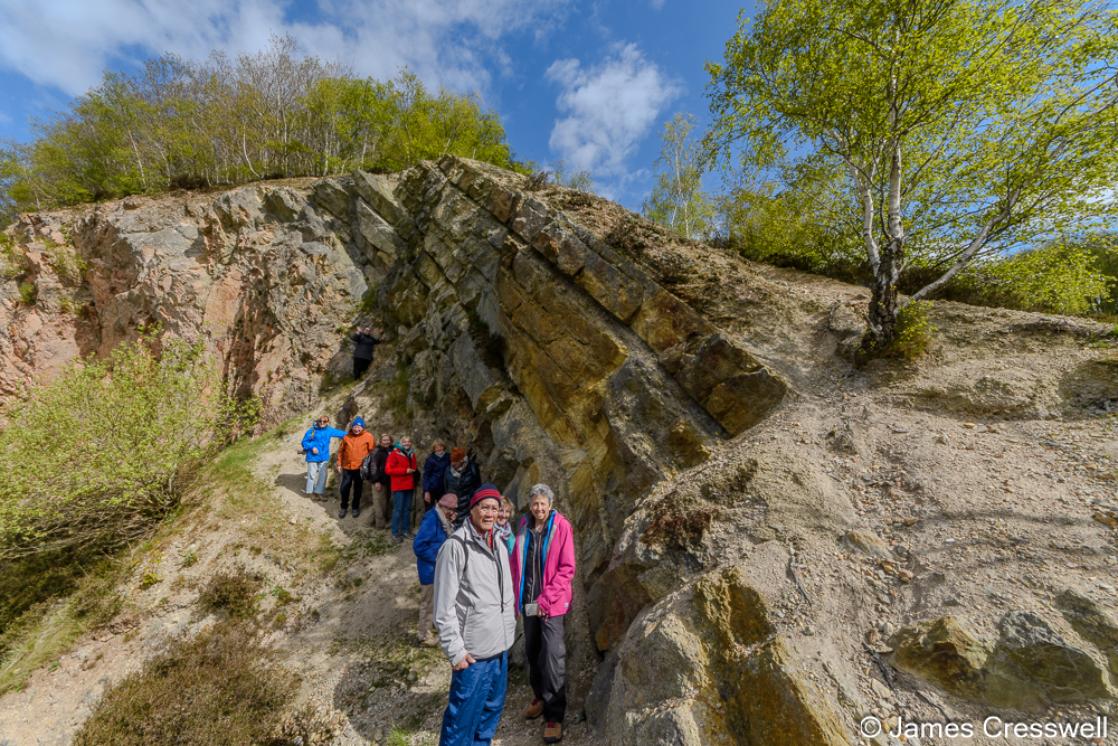
PHOTO DIARY 2023
A fully-captioned photo diary of the trip
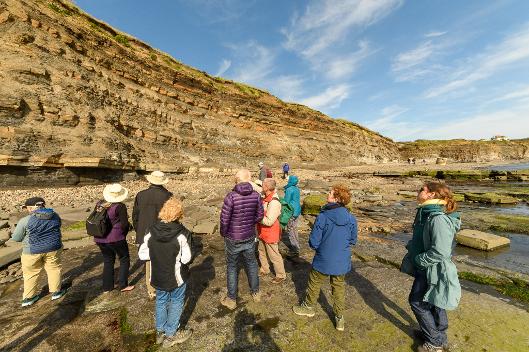
TRIP DIARY 2022
A day by day account of the trip with captioned photos
A DIARY of the Wales (only)2019 Trip
A day by day account of the trip with captioned photos, and includes some sites which are not featured on the current itinerary
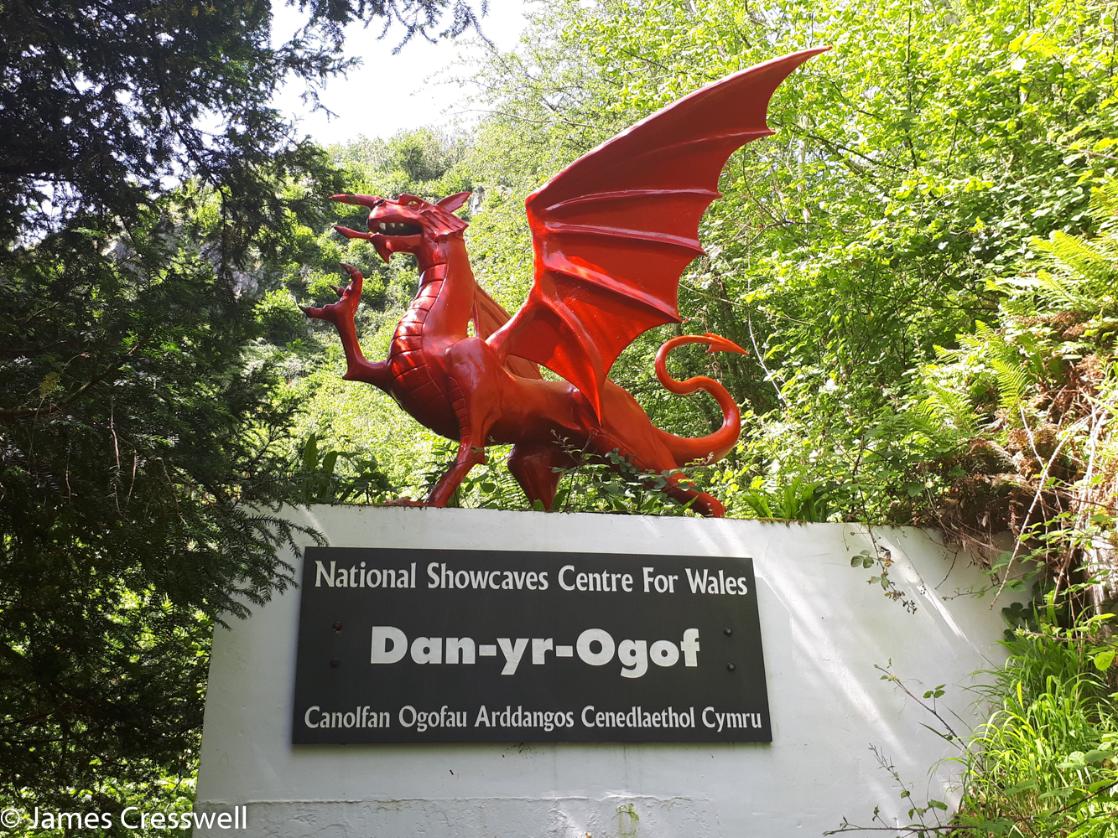
ENGLAND & WALES - JURASSIC COAST & THE COMPLETE GEOLOGIC TIMESCALE (2025)
"The England/Wales trip was a mind blowing experience, condensing 650 million years of earth’s history into two weeks and James and Abby managed to pull it off with an itinerary that consisted of visiting numerous geological sites from southern England to Northern Wales. A deep dive into geology; both with respect to our own rock and fossil treks from the Jurassic to Precambrian periods, and the eminent geologists who established this timeline. With a 60 page handout and extensive narration by James, we learned first hand how these time periods were identified. It’s always a pleasure to be with a group of 15 people who share a passion for geology and our hammers and walking poles got a workout during our daily outings for rocks, fossils and unconformities. A special shout-out to our bus and bus driver, hotel meals and our fearless leader who has an awesome knowledge of geology. Be warned that this trip is for physically active adults. At times the terrain was difficult and required some skill in rocky uphill and downhill grades. Overall, this tour provided a detailed exploration of the geology of the region and I would recommend it to all those interested in this discipline."
Ellen B., California, USA
Review sent to us by email, May 2025
ENGLAND & WALES - JURASSIC COAST & THE COMPLETE GEOLOGIC TIMESCALE (2024)
"This tour, led by Geologist James Cresswell, is a comprehensive review of the complex geology found in selected areas of England and Wales. It is of interest to the professional geologist as well as non geologists. We had a wonderful mixture of people on the tour from the US, Canada, England and Australia. The tour included history, archaeology, scenic landscapes as well as geology. We were also given the opportunity to find our own trilobites and ammonites, among other fossils. These trips are well organized by James and his partner Abby. I would highly recommend any of James' GeoWorld trips if you want to learn and have a great time doing it!"
Deborah L., Tennessee, USA
Review sent to us by email, May 2024
ENGLAND & WALES - JURASSIC COAST & THE COMPLETE GEOLOGIC TIMESCALE (2022)
"England and Wales with GeoWorld Travel -You Don't have to be a Geologist to Enjoy this trip Fantastic trip. James and Martin were great guides. As someone with no training in geology, I was worried that I would get lost during the trip discussions.. That didn't happen. At each site the discussions ranged from the simple explanations of what we were looking at and why we were looking at it ( for me and another traveler), to complex discussions for the more serious minded geologist. I learned a lot about geological time periods not only from James and Martin but also from my fellow travelers who were fun to travel with.. Additionally, I got to search for, and find fossils from the Jurassic, Silurian, and Ordovician period. The group also had a great time at some historic sites. The coal mine and the prehistoric copper mine were amazing. There was also a trip to the world's first iron bridge and different heritage sites and parks. The trip was made even better through Abby's help with reading recommendations, packing advice, return of a left behind cell phone and numerous other arrangements. I enjoyed the trip so much, I already signed up for another trip this year (Morocco)."
Deborah S., Washington DC, USA
Review was posted to Tripadvisor, September 2022
ENGLAND & WALES - JURASSIC COAST, & THE COMPLETE GEOLOGIC TIMESCALE (2022)
"Excellent trip. I went on the England and Wales tour of the “Jurassic Coast and the complete geological timescale” trip with James and Martin as the accompanying geologists. They were excellent and gave us lots of interesting sites to see and discuss . There were 11 people on my trip , some were experienced geologists themselves, so it gave for interesting discussions and insights into the features observed. What was so impressive was the that the discussion was suitable for non-experts as well, and everyone was engaged and was able to benefit from the fascinating geology on offer. On top of that were opportunities to see some of the most beautiful parts of SW England and Wales. For me the very interesting industrial history, central to understanding the birth of the industrial revolution, were available as well. This was such a very interesting bonus for me. I had trips down mines which were fascinating in themselves. A lot of effort was put in by James to ensure that we were able to get to see lots of sites which fitted in very well with the development of the history of geology as a science . An excellent overview of development of historical stratigraphic sequences was provided. Hotel accommodation was good too. I highly recommend this trip for the intelligent traveler interested in seeing some of the most important geological sites in England and Wales with lots of World Heritage sites included as well."
Alan D., Kent, UK
Review was posted to Tripadvisor, May 2022
ENGLAND & WALES - JURASSIC COAST & THE COMPLETE GEOLOGIC TIMESCALE (2022)
"Jurassic Coast and the Complete Geologic Timescale tour was incredible. It was a truly informative trip through stratigraphy taking account of the industrial revolution. We shall observe landscapes in a totally different way. It was mind blowing developing an understanding of the complexity of development of stratigraphy. The areas visited all had great significance in the history of geology.Travelling to many diverse locations with other interested people made for lively discussions about geology, politics and so on.We managed to pick up some fossil rocks on the way. James and Abby Cresswell have given much thought to the itinerary and it has been truly inspiring to part of their tours for a second time. We shall be booking again"
Roger B., Cardiff, UK
Review was posted to TripAdvisor, May 2022
Before 2022 this tour was runas two different shorter trips and the reviews below relate to those itineraries:
ENGLAND - JURASSIC COAST AND CORNISH TIN MINES (2019)
"I joined the tour going through southwest England because of my novice interest in fossils and the Lyme Regis area. Boy did I learn a lot! Our guide James geared trip locations and background information to fit into our existing framework of knowledge and physical capabilities. Exciting moments; climbing Haytor partway in blustery weather, hiking down into coves where the ocean swash rumbled the cobble shore, seeing ancient sites of rock lined avenues, following sauropod tracks across a quarry, experiencing life of a tin miner going to work, and touching rocks that were part of the Earth's mantle before being pushed up and over a continental plate. Because it is such a small group, we didn't experience lost time in gathering folks, and we were easily able to ask James questions, including "why are the roads so narrow", and "how often do you see hedgehogs?" What I will always remember is the absolutely beautiful land of southwest England, and the graciousness of all the people we met. James and Abby were extremely helpful in arranging my early departure to catch a boat; they were a pleasure to work with. I hope to join GeoWorld Travel for my trip to Iceland in 2020, since this year's is full. Don't delay, sign up early."
Margaret R., Texas, USA
Review was posted to TripAdvisor, May 2019
ENGLAND - JURASSIC COAST AND CORNISH TIN MINES (2019)
"This trip was a great pleasure to go on! James is a fun and knowledgeable guide, providing not only an interesting geological perspective, but a lot of local flavor as well. Geology is combined with stunning scenery, as well as a variety of activities such as fossiling, visiting caves, museums, and neolithic sites. We visited charming coastal towns, staying in some lovely bed and breakfasts. We enjoyed eating in the local pubs and tea rooms as well. This was our first trip to the UK. We found it to be a unique and personalized experience and a great value for the price."
Nancy C., Virginia, USA
Review was posted to TripAdvisor, May 2019
ENGLAND - JURASSIC COAST AND CORNISH TIN MINES (2017)
"Hi James. Barbara and I wish you at great new year. We want to thank you for a most interesting trip this spring to the English South coast. Interesting sites, good company and a lot of geology. Even the weather was nice! Best wishes"
Torsten H., Sønderborg, Denmark
Review was posted to Facebook, December 2017
ENGLAND - JURASSIC COAST AND CORNISH TIN MINES (2017)
"We got a good tour of the South West in Somerset, Devon and Cornwall and tried our luck as fossil hunters in Lyme Regis. James is a jovial and knowledgeable guide and he selects each destination for its geological relevance- which usually coincides with beautiful and unique landscapes. With just 4 of us on the tour, we got to have some interesting conversations and get to know each other. We found ourselves very tired at the end of each day, having seen several interesting places. Most of the places we visited were outdoors and we counted ourselves lucky that it didn't rain for the entire week of the tour.
Recommended for anyone who hasn't seen the South West or who has once wondered why landscapes look the way they do. If you have a particular interest in geology and/or fossils, this trip is made for you. Bring good shoes and prepare for the English weather!"
Barbara H., Alpes-Maritimes, France
Review was posted to TripAdvisor, April 2017
WALES - CASTLES AND DRAGONS (2013)
"A Tour of Wales in May 2013, with resident geoscientist James Cresswell, in our opinion rated 5 stars in all categories! It was a well-chosen blend of geology, history, culture, and scenery impossibly packed into seven days. Travel for our small group was by car on sealed roads and entirely satisfactory; accommodation was usually in mid-range hotels but included a superb B&B in Brecon Beacons National Park (Tara, Felindre). We could not have had a better leader: warm, cheerful, knowledgeable, attentive to our every wants and needs. Thank you, James! The range of geologic sights was amazing; surely something for everyone. Paleontology was the lead-off subject. On arrival evening we were picking up ammonites on the beach near our hotel, and the next day following a Mesozoic dinosaur trackway; in subsequent days searching out graptolites and trilobites (Wales hosts the Type Sections for the Cambrian, Ordovician, and Silurian ). A focus on economic geology? Visits to once world-famous but now mostly inactive coal, slate, gold, lead-silver mines and related industrial facilities (in the 19th C. Wales was unsurpassed in coal production). Structural geology and tectonics? Multi-stage structures splendidly exposed in sea cliffs; extraordinary coastal displays of melange; glauconite-rich blue schists from deep in the crust or upper mantle; pillow basalts; silicic ash-flow tuffs; and more. It was amazing to contemplate that we could walk terraine once ripped from what is now Newfoundland during the sundering of Gondwana! Interspersed with all this geological variety are relics of human activity dating from earliest times on: dimension stone destined for Stonehenge; steles; ancient crypts; even a rare "crannog" ; walls, forts, castles, priories, etc., testimony to vicissitudes of Celtic, Anglo-Saxon, and Norman preeminence and strife. We found it impossible to absorb and digest everything on our plate on this all-too-brief tour but we expect it to provide sustenance for years to come! Hats off to GeoWorld!"
Dick B., California, USA
Review submitted via email, July 2013
WALES - CASTLES AND DRAGONS (2013)
"Our holiday was a fantastic tour-de-force through the geology, scenery, history and culture of Wales visiting 2 Geoparks, 3 National Parks and 2 World Heritage Sites - all in one week!"

